Before I start my usual train-spotting related content, I just want to very briefly ponder over this very moment — apparently this is pretty much how my first year in the UK ended. All mini metro games always end a bit too fast and a bit too unexpected, leaving you miserable at times and frustrated in other times. This is how I feel right now.

That said, I’m glad had all these exciting experiences — enduring through a stressful but fruitful (half) year of education, participating in activities like robotics and skating, meeting new friends in school and in church, and of course, doing a bit of train-spotting with my new friends from rail society. I wish I did a bit more travelling, but right now I’m just happy to be back in Hong Kong. Maybe later I’ll put together an album of memories for this academic year, maybe not……… anyways this article is supposed to be focused on trains!
Every major train journey I’ve had starts in state of uneasiness. We missed our original train from Shenzhen to Guangzhou due to long ticketing queues and almost missed our train to Tibet during our 2019 graduation trip. For our 2019 Wales and Ffestiniog Trip, we almost missed our train to Birmingham new street, though that was not actually that severe since we could have got on a later train (a much later one) instead. For my most recent trip to Gatwick Airport, I almost messed up for being in the wrong part of the train, since the front 4 coaches were divided at Redhill and headed for somewhere else.
I guess that’s part of being a train enthusiast, who always makes predictions that are way too optimistic. Imagine the countless number of station announcements whirling in your ears mixed with all the nonsense twirling in your mind. For this January train-spotting trip, things are a slight bit different, in that there’s less frantically chasing trains, and more like trains chasing by us.
The motion blur photo below is of an Avanti West Coast Pedolino speeding by Watford Junction, taken at a time when we weren’t quite chasing trains. The chilling gust of wind as the train busts through is quite shivering though.
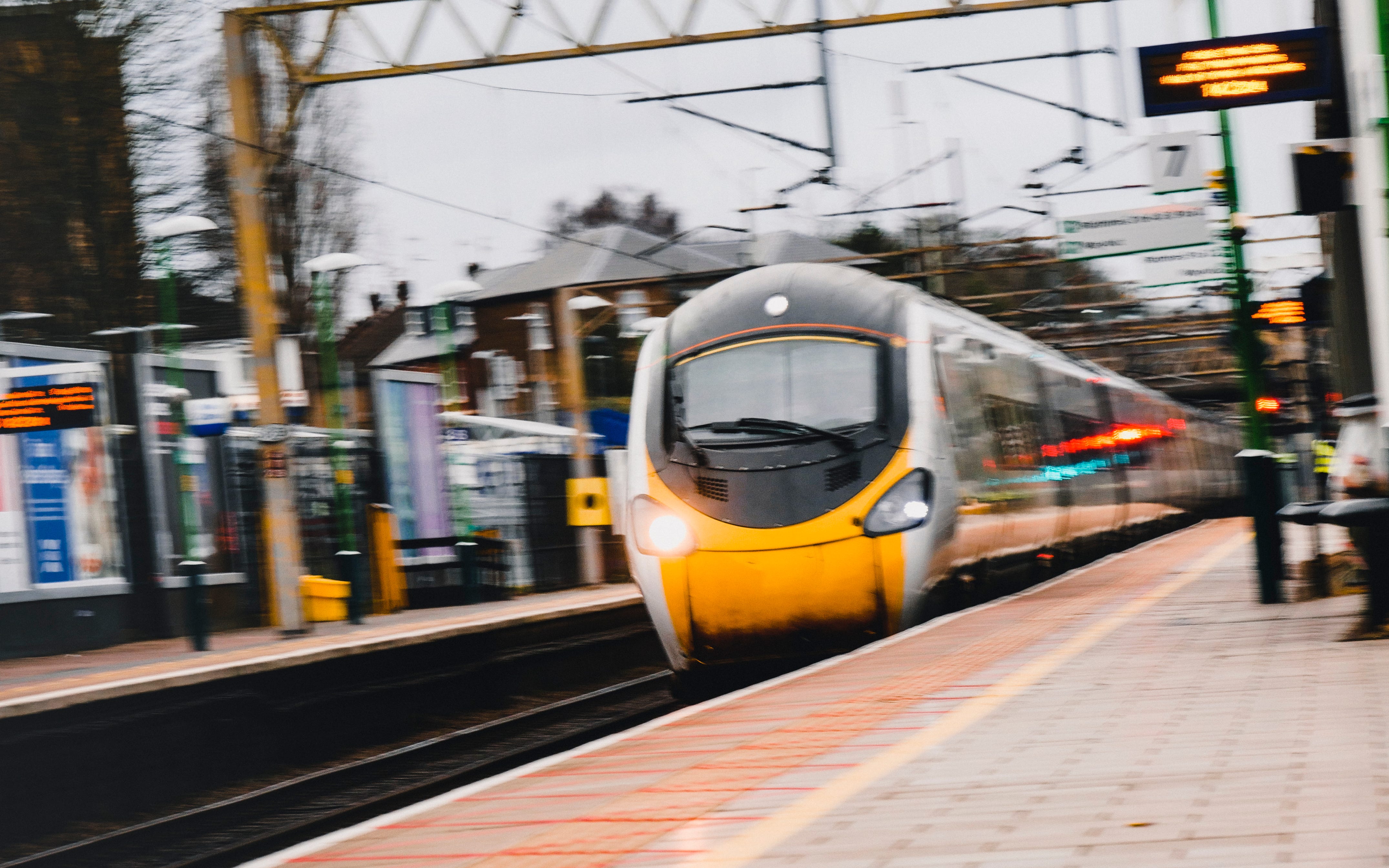
During our last trainspotting trip in November, we somehow managed to go beyond the maximum travel time which costed us quite a bit; in fact, we paid nearly double the daily cap price for zones 1 to 4. This time around, with a bit more careful planning, we managed to stay within the cap for zones 1 to 2. We made sure we stayed within the 1 hour 50 min limit (for zones 1 to 2 on weekends). Our planned and actual itenerary are as follows:
Schedule
Leg 1: From South Kensington [1] to Canary Wharf [2] (<1hr50m)
- (10:00 Enter South Kensington)
- 10:30 Bank Platform 9 DLR
- 11:00 Arrive Canary Wharf, exit station; possible attractions: Crossrail Place
Leg 2: From Canary Wharf [2] to Clapham Junction [2] (<1hr40m)
- 11:40 Enter Canary Wharf
- 12:00 Arrive at Lewisham
- 12:09 Lewisham Southeastern Train to Waterlooeast (trains to Charing Cross, at 09, 16, 36, 46 every hour)
- 12:25 Arrive Waterlooeast, walk to Waterloo
- 12:40 Arrive at Clapham Junction by London Southwestern (must not exit later than 13:00/13:20)
Leg 3: From Clapham Junction [2] to Euston [1] (<1hr50m)
- 13:40 Southern Train to Watford Junction (train to to Milton Keynes Central)
- 14:20 Arrive Watford Junction
- 14:35 West Midland Trains to London Euston
- 14:53 Arrive Euston (must not exit later than 15:10/15:30)
Remaining Legs
- Walk to Reagents Park
- Bakerloo Line to Wilesden Junction
- Overground back to Kensington Olympia
In a totally British fashion, most journeys were actually a slight bit delayed, though they did not cause us any major setbacks in terms of delay times and fares.
Leg 1
Not many photos were taken during leg 1 since it was mostly travelling in the underground anyways. As expected, we ended our first leg of our journey at Canary Wharf. Interestingly, we managed to catch a DLR train that arrived at the middle platform.
If you look closely at the photo, you can literally see the platform of West India Quay right behind the tip of this train (it looks like so but physically not so). This shows how close the two stations actually are. In fact, I think I have never even seen two bus stops so close to each other.
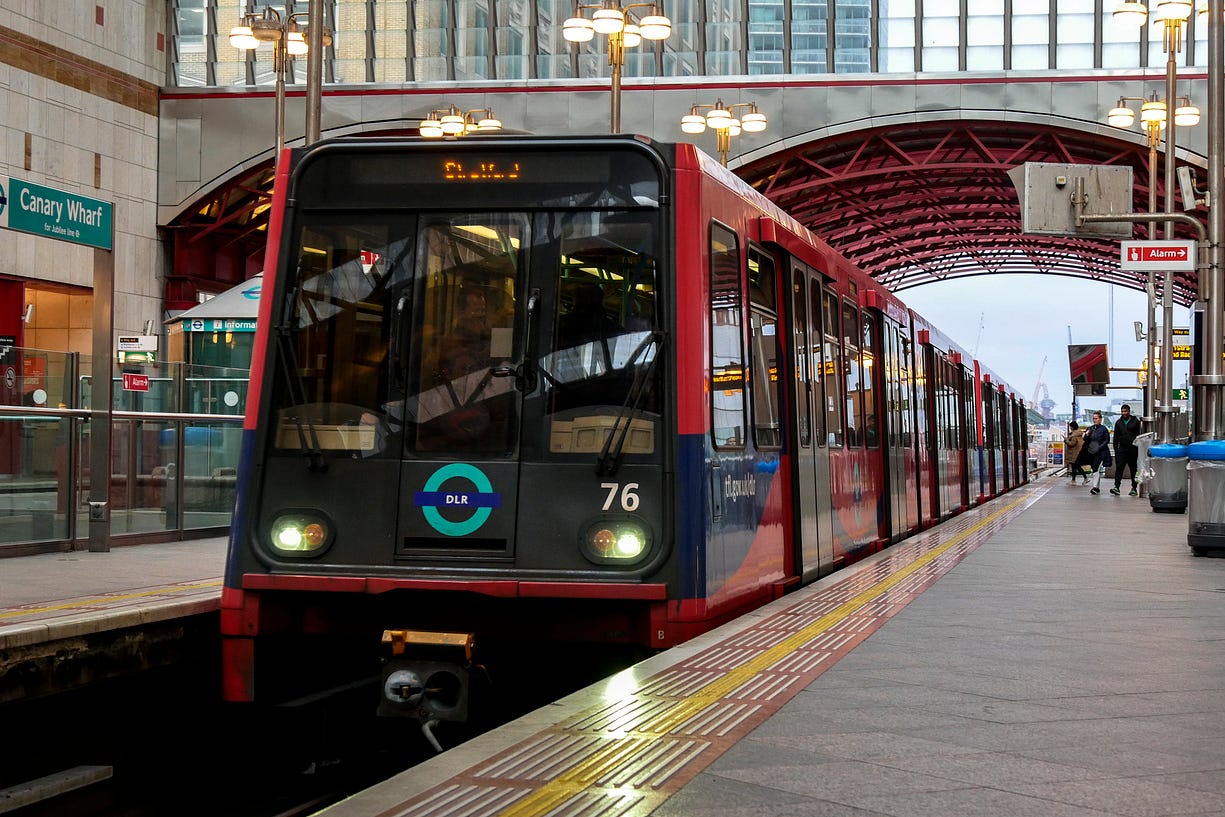
During this half an hour break, we walked around Canary Wharf, went to take a peek at the future Crossrail station and ended up at Poplar.
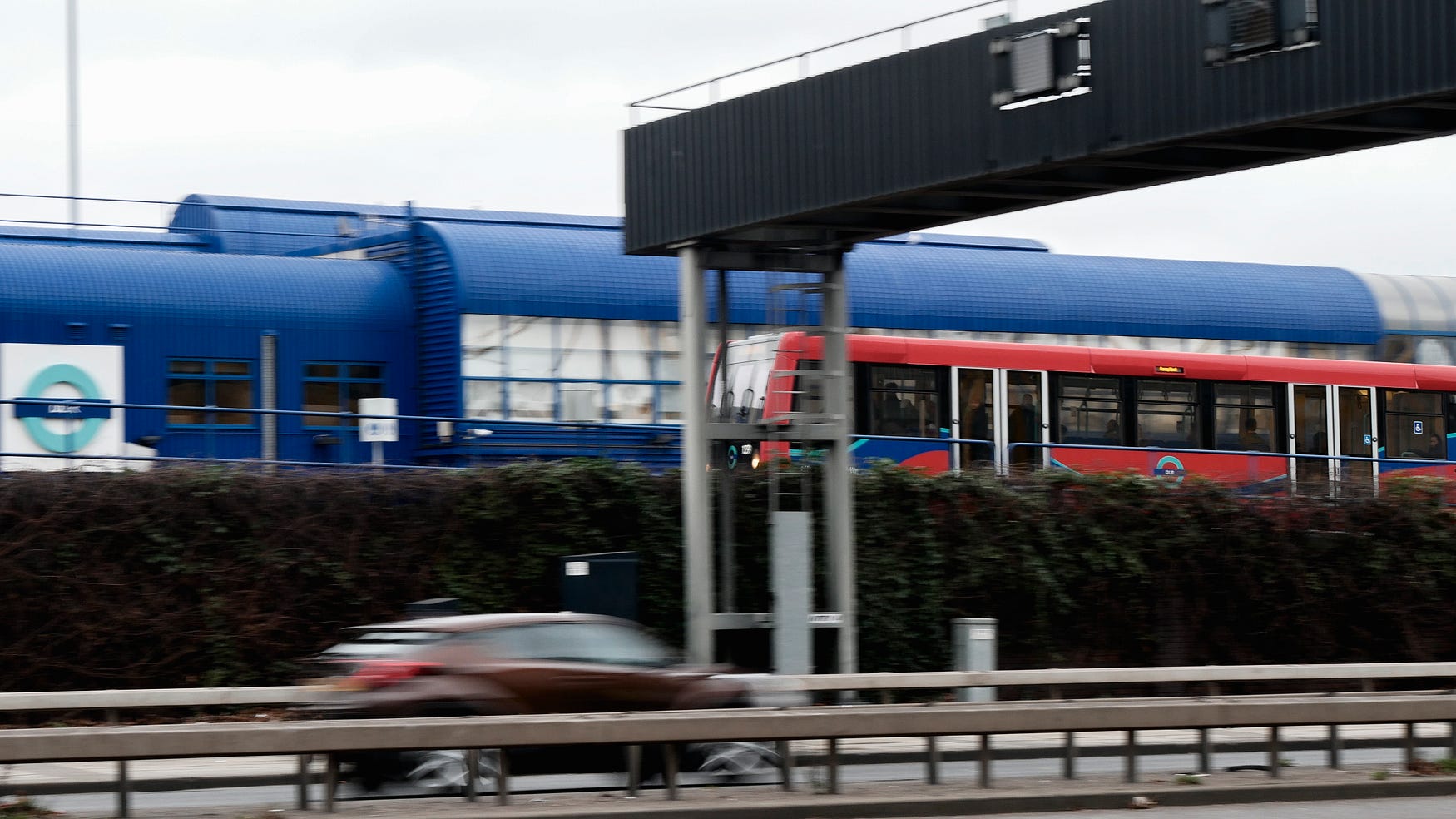
It looks like a pretty new station, and as you can see the platforms are covered with glass roofs. Oddly enough, the cover does not extend to the cover of the staircase. I wonder what the designers/ engineers were thinking……
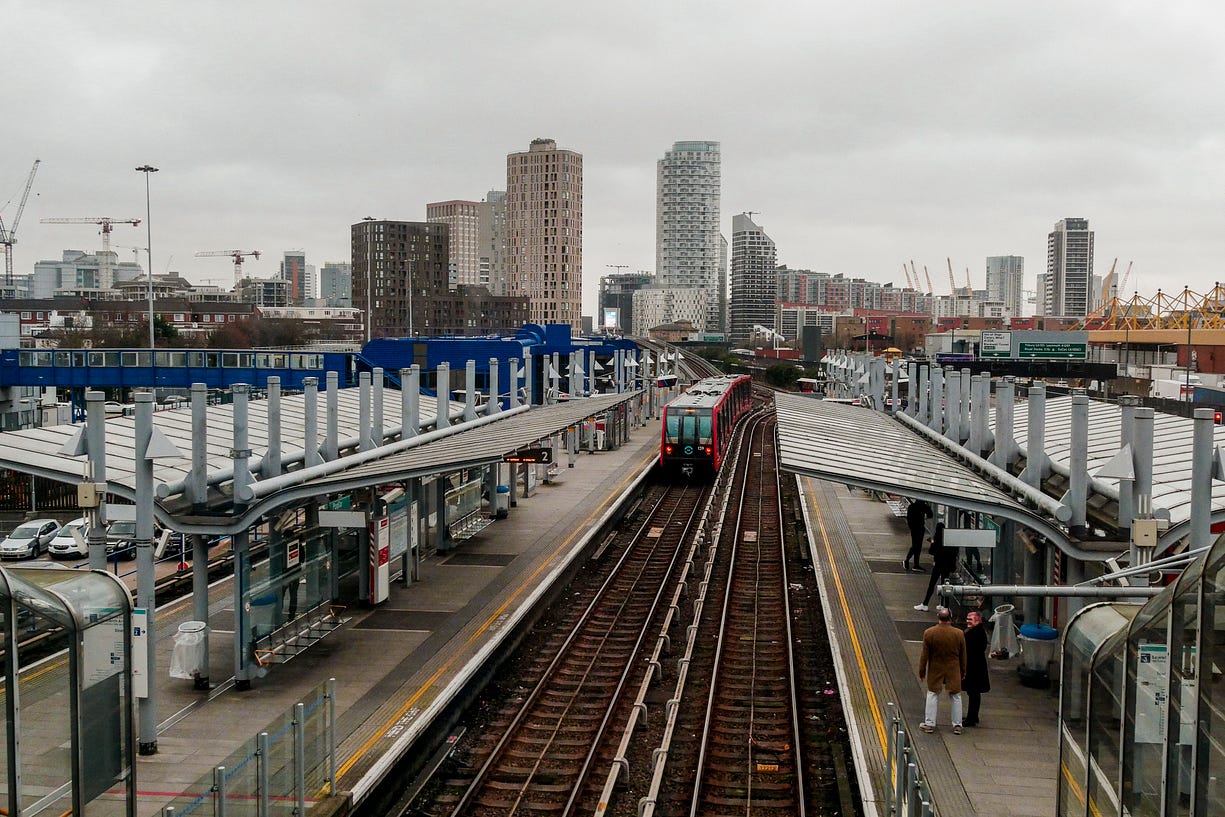
Here’s a peek of one of the DLR’s depots, located right next to Poplar. Maybe it’s a convenient location for sending trains to London Bank in the morning, but the entrances are positioned in the other direction.
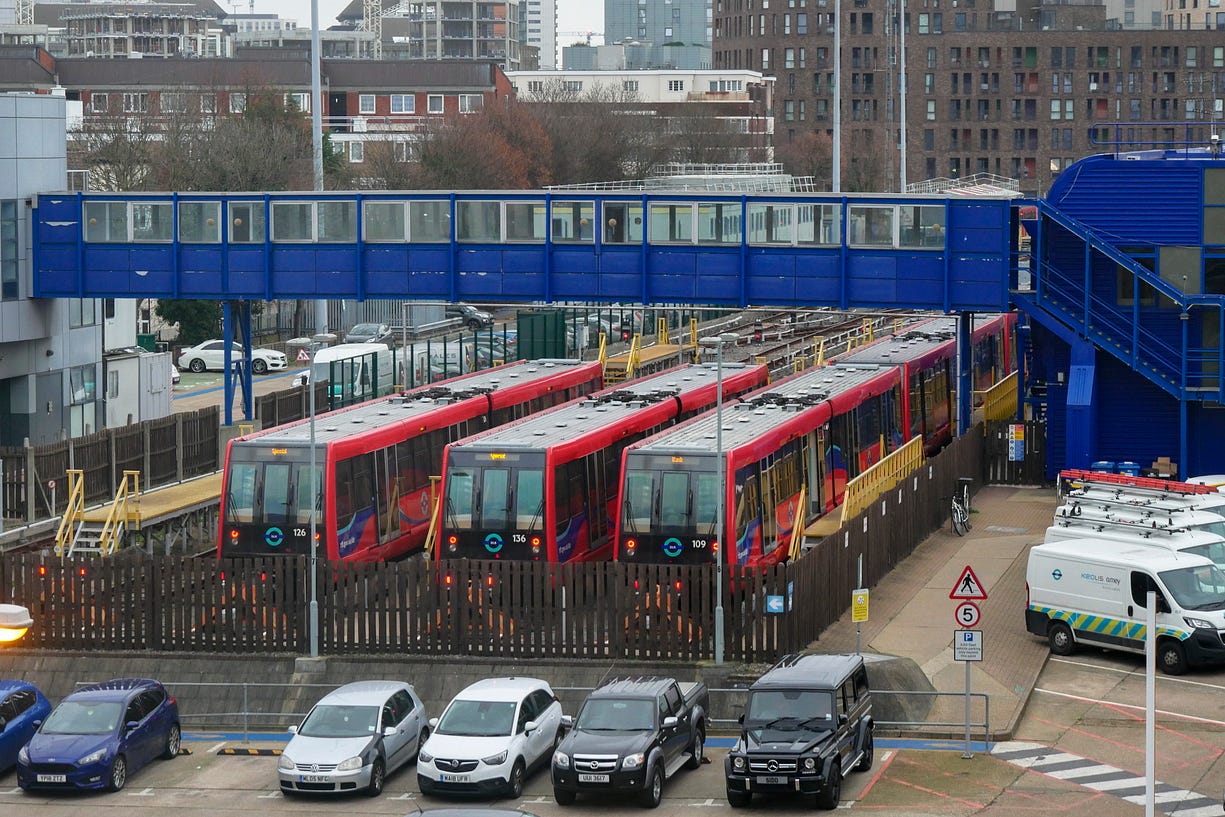
On the other side of the bridge we get a panoramic view of London’s city skyline (at a distance). I did spend some heavily editing this photo because the glass pane is so murky. The colours still end up a bit weird though.
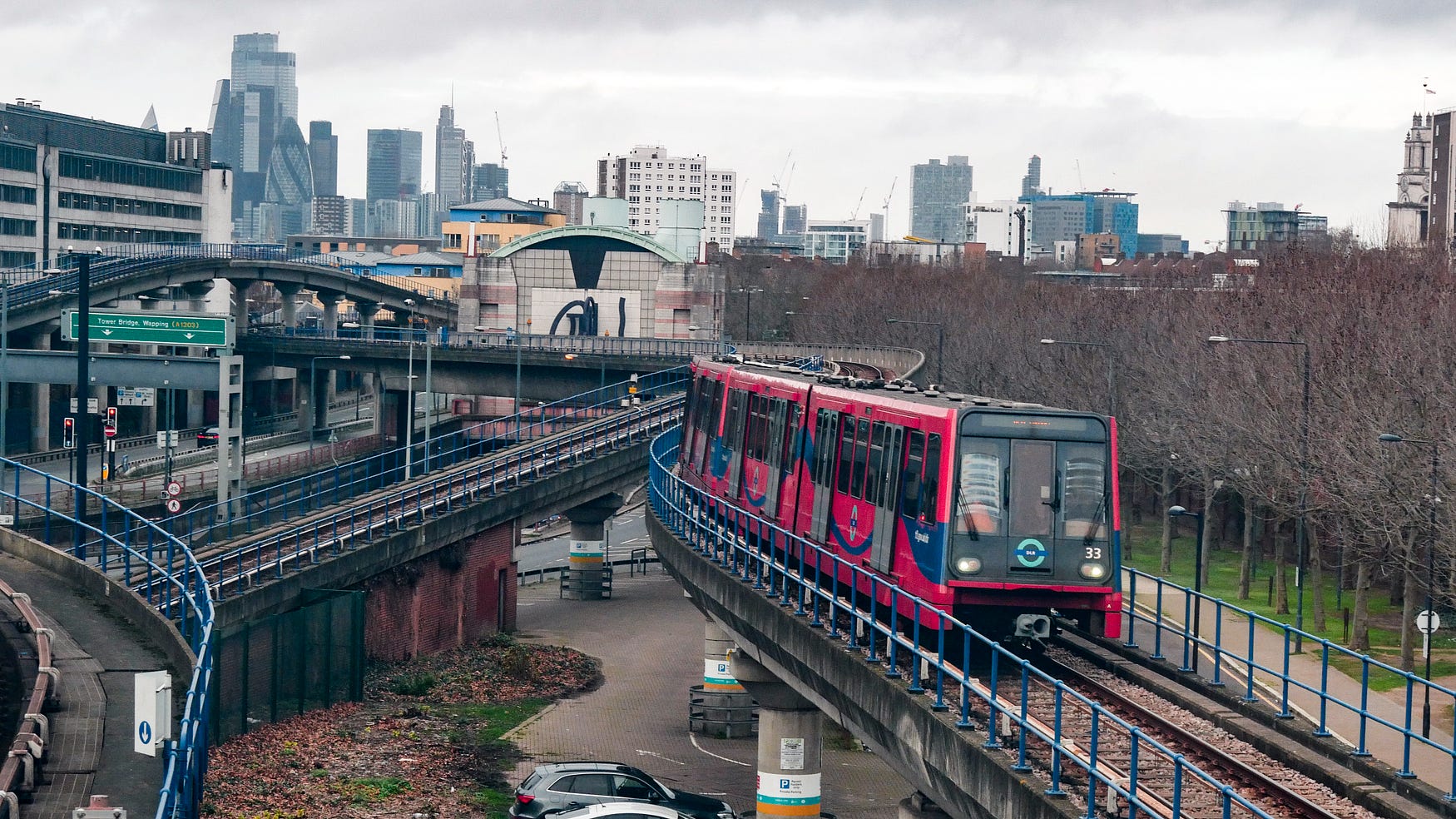
On a side note, new DLR trains are on the horizons, and they will replace the B90/92/92K stock pretty soon (soon in a British sense).
Leg 2
We then continued our second leg of our journey south towards Lewisham. Did I mention that the trains are driverless and that passengers get the driver’s view? This has always seemed like a pretty new idea to me, but a little bit of digging into the DLR’s history proved me wrong — this has been implemented since the start of the DLR system in the 1980s.
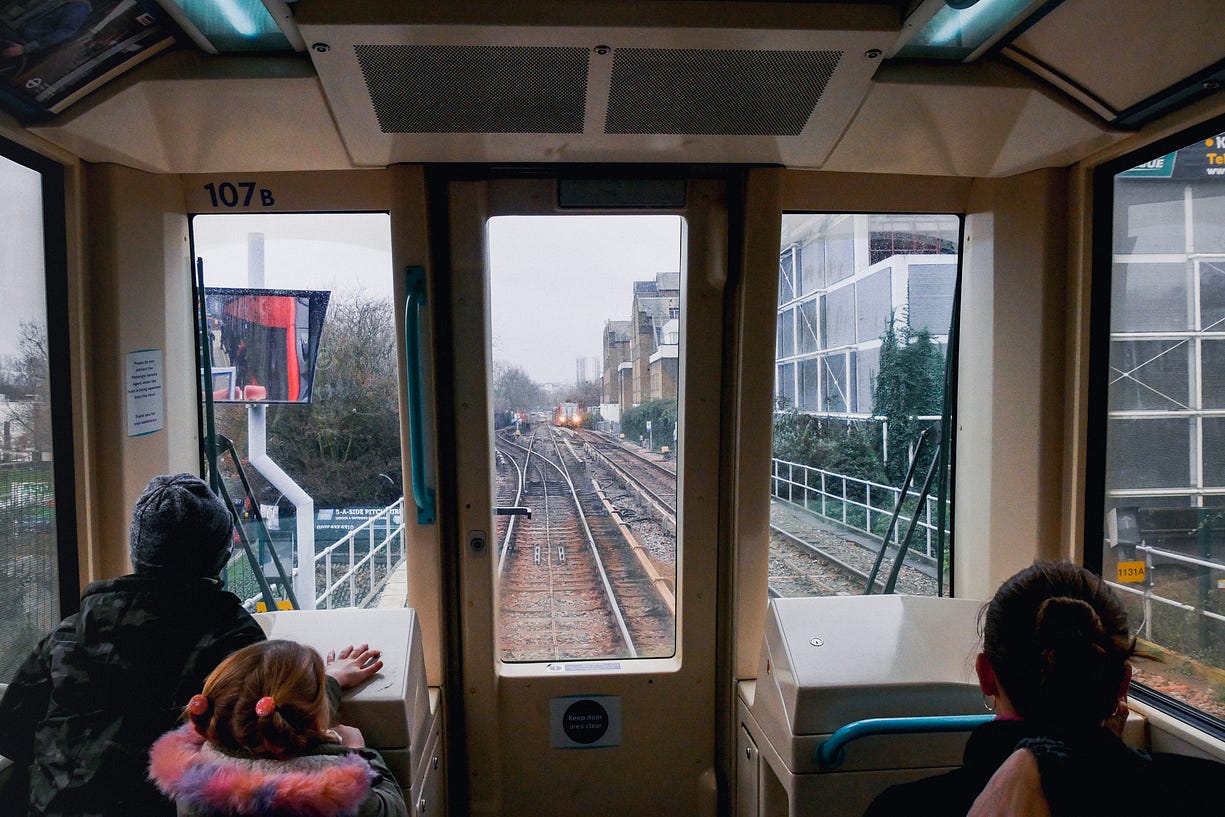
Mud-chute? A little chuckle from both British and Hong Kong trainspotters.
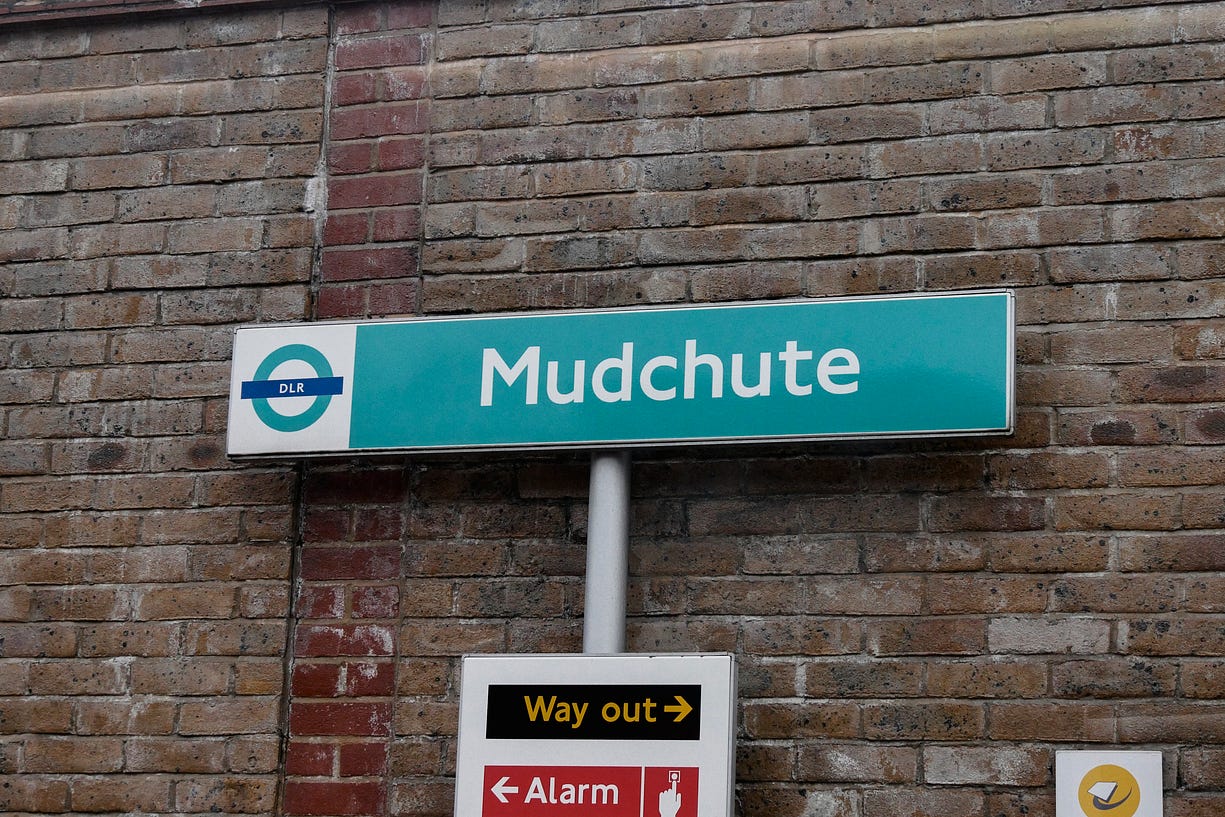
For those of you who have never been on a DLR before, the teal/ turquiose coloured handrails looks cute.
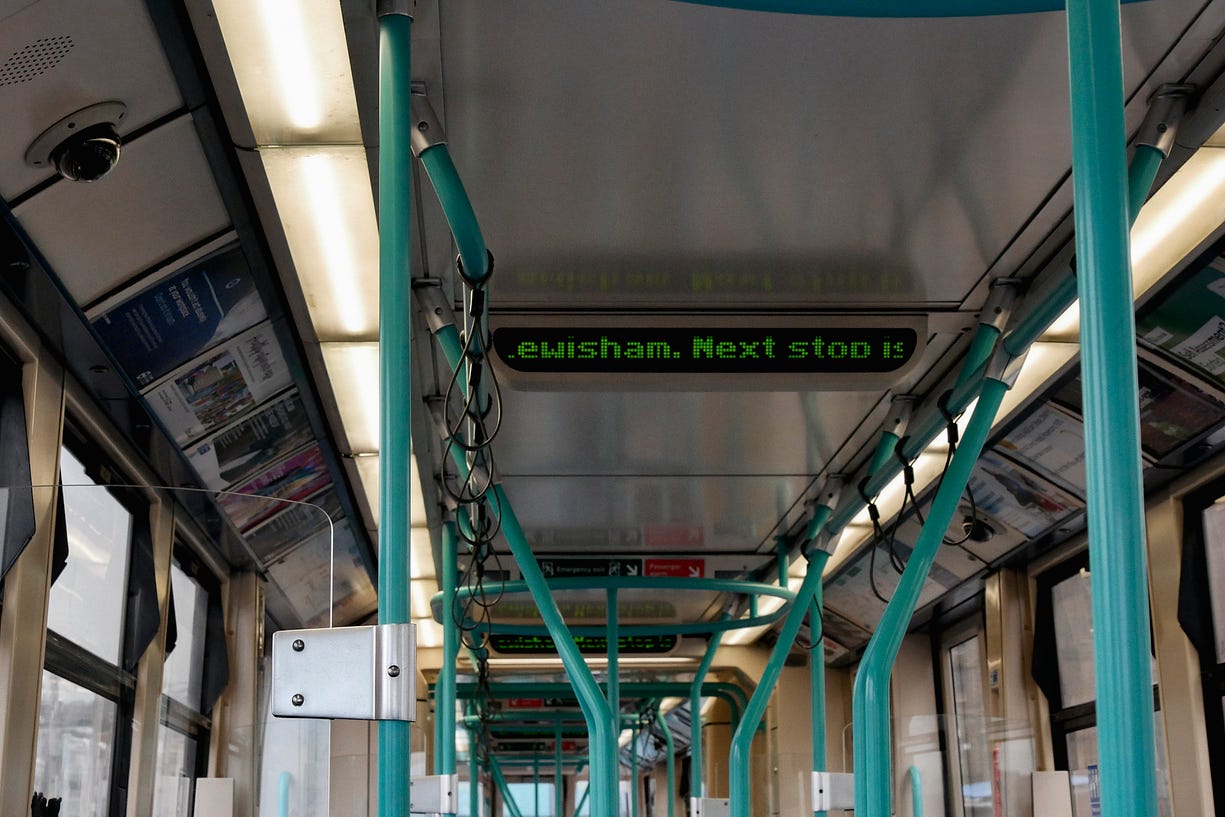
We then caught our Southeastern train to Waterloo East. I didn’t manage to take photos on the platform because it was quite crowded. I think we would have actually missed this train if it wasn’t delayed, so in this scenario I guess I should be thankful for the National Rail’s inefficiencies.
Here’s a view of a Northbound Thameslink as we departed London Bridge.
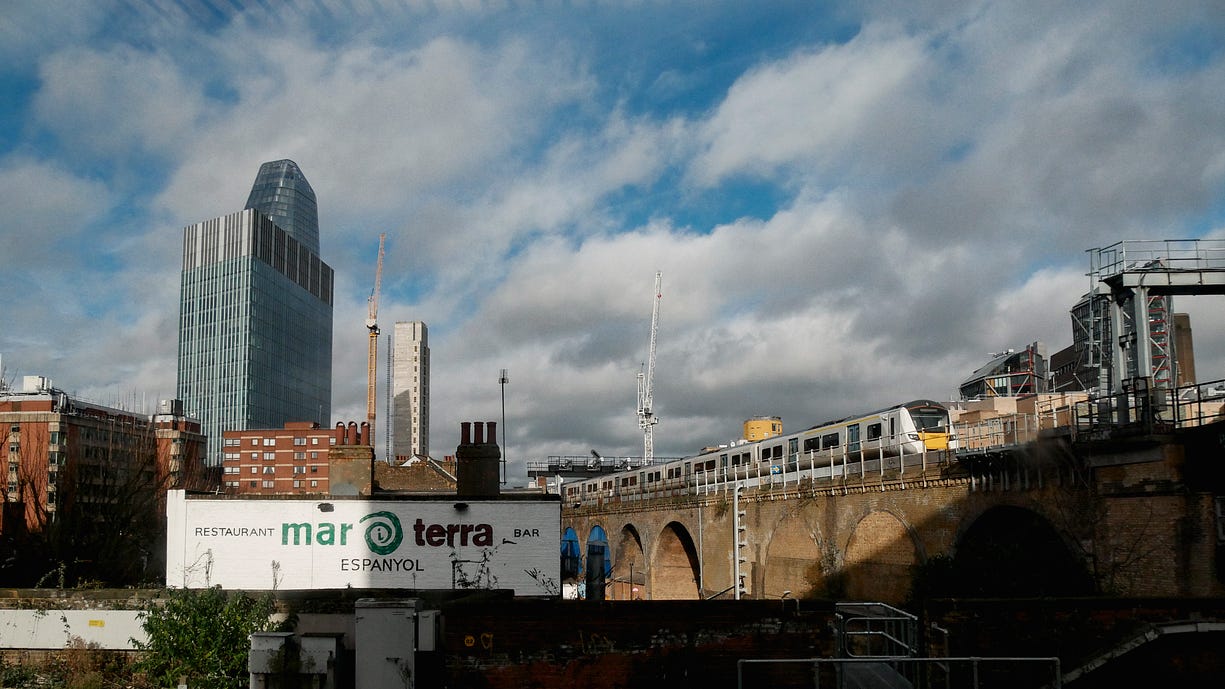
And here’s a shot of the crowded Class 455 that took us to Waterloo East. These class 455s are common on Southeastern.
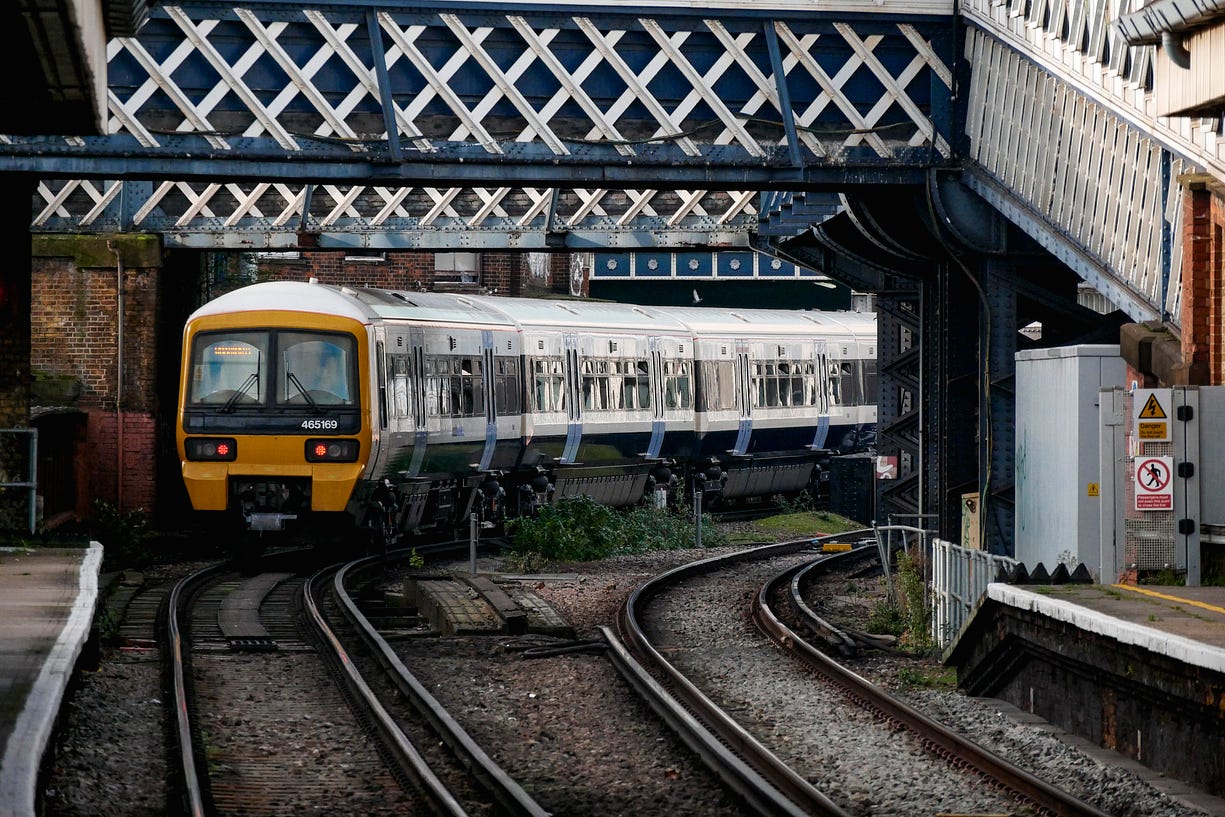
Interestingly, different carriages of the train are produced by different companies. The rear 4 coaches are produced by ABB, which was one of the subcompanies that formed Ad-Tranz, i.e. the company that produced the Airport Express and Tung Chung Line trains in Hong Kong.
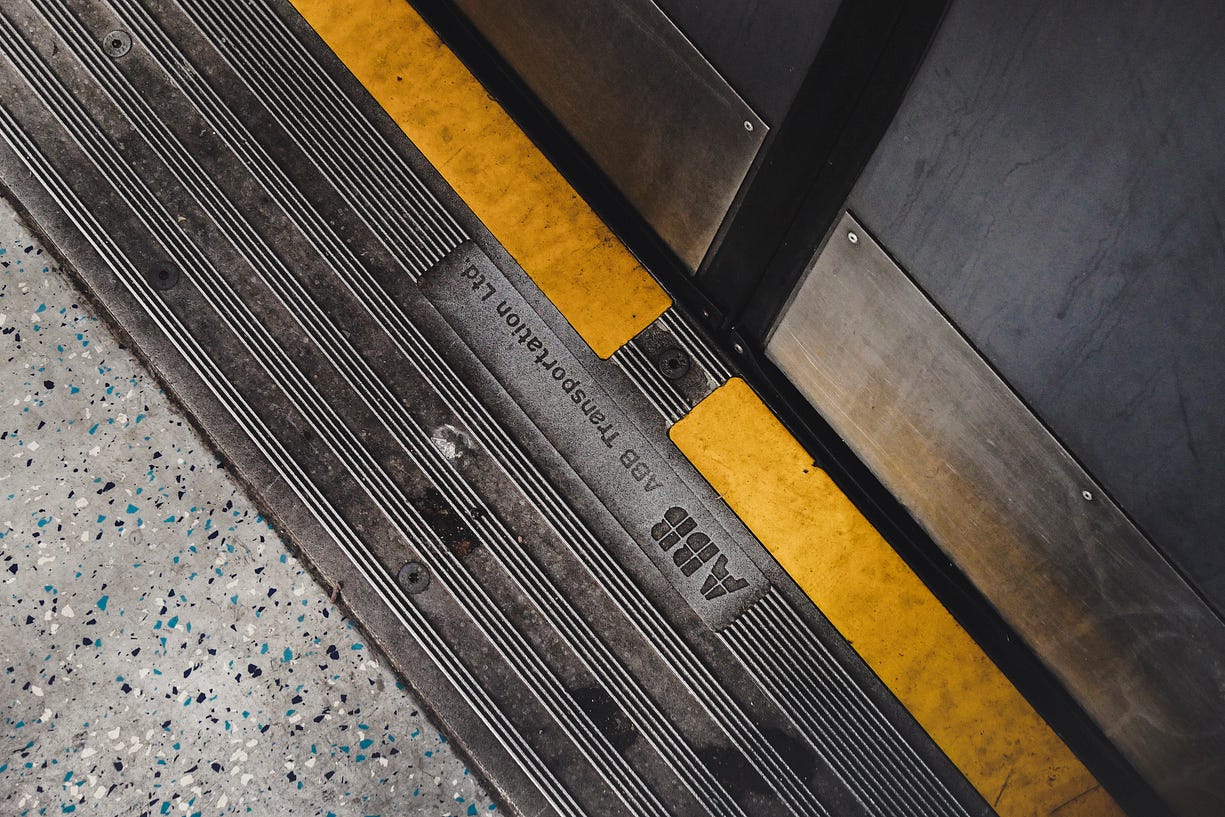
The front 4 coaches are produced by British Rail Engineering Limited (BREL) , which was the railway systems engineering subsidiary of British Rail until the design and building of trains in the UK was privatised in 1989. Turns out it was later brought out by ABB, which is part of Bombarider today.
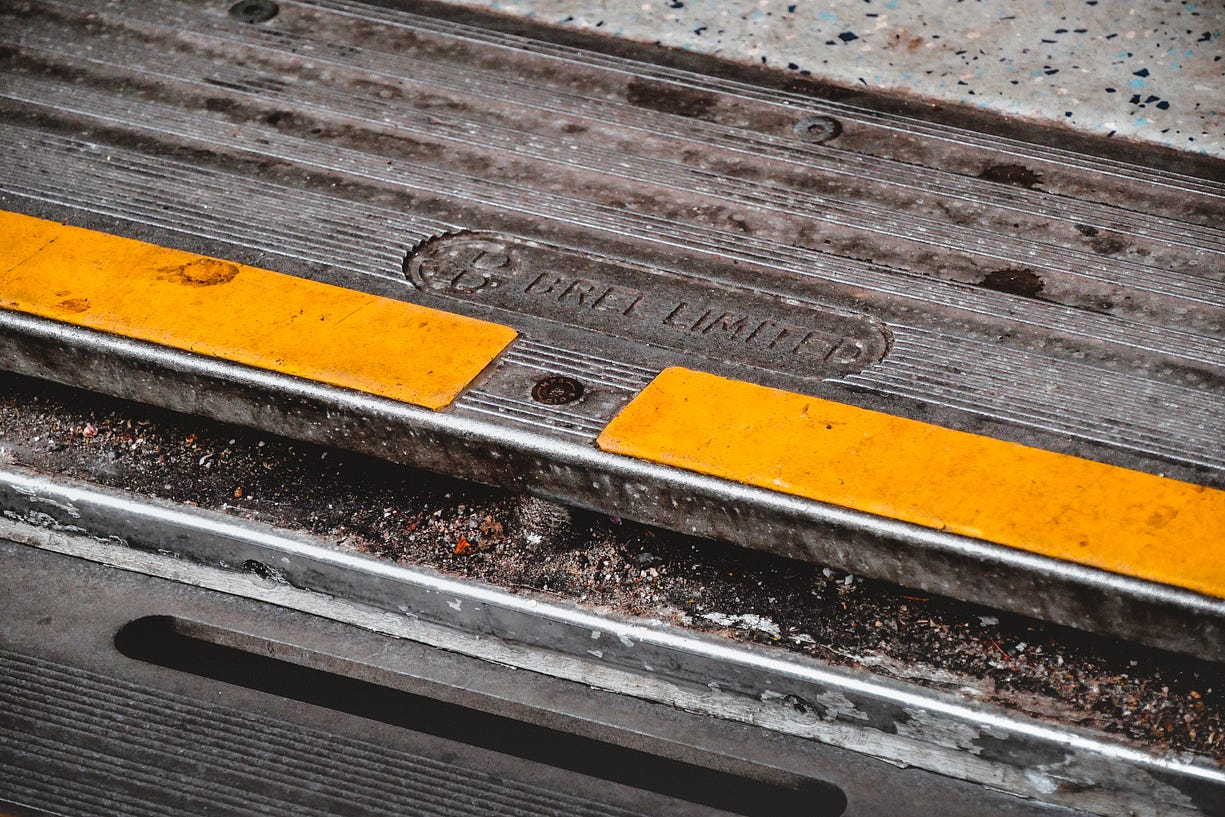
The fact that they are in the end pretty much related to each other reminds me of agar.io (gulp)
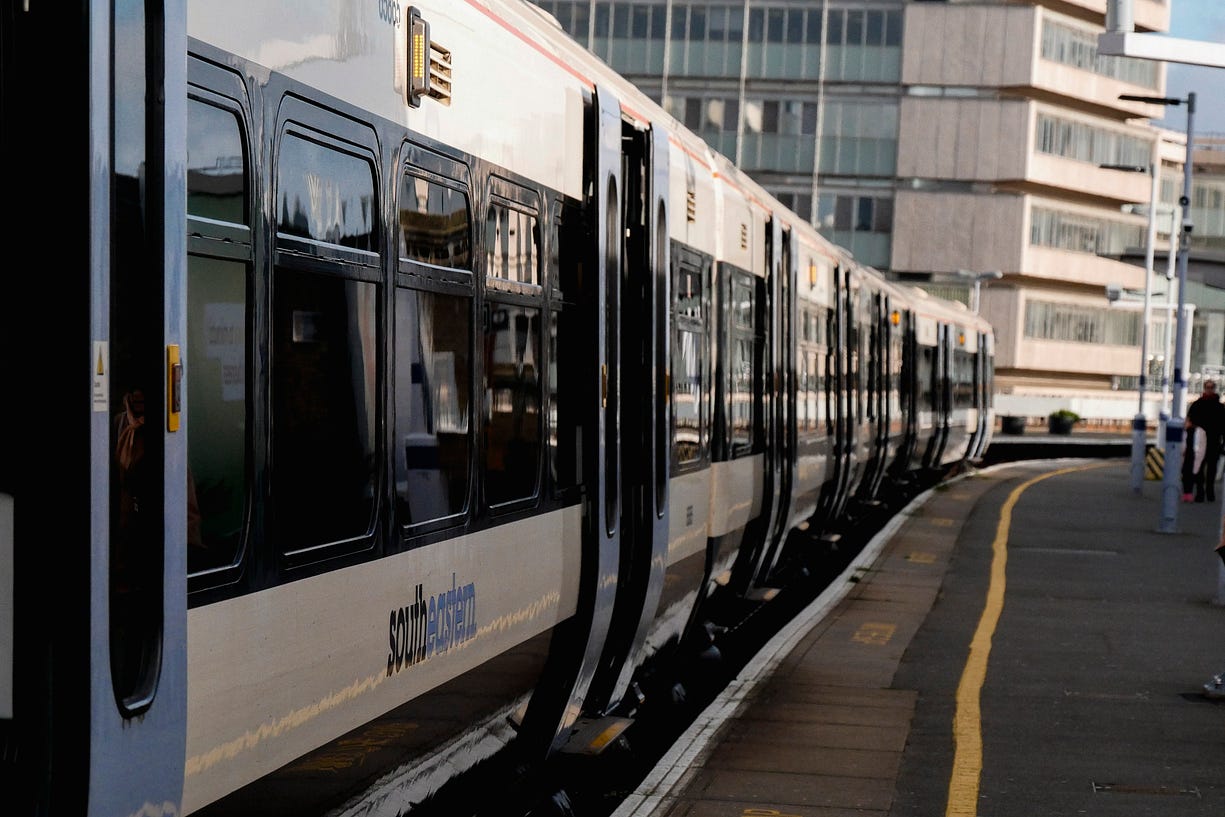
A closer view of London’s skyline, as the train continues its journey to Charing Cross.
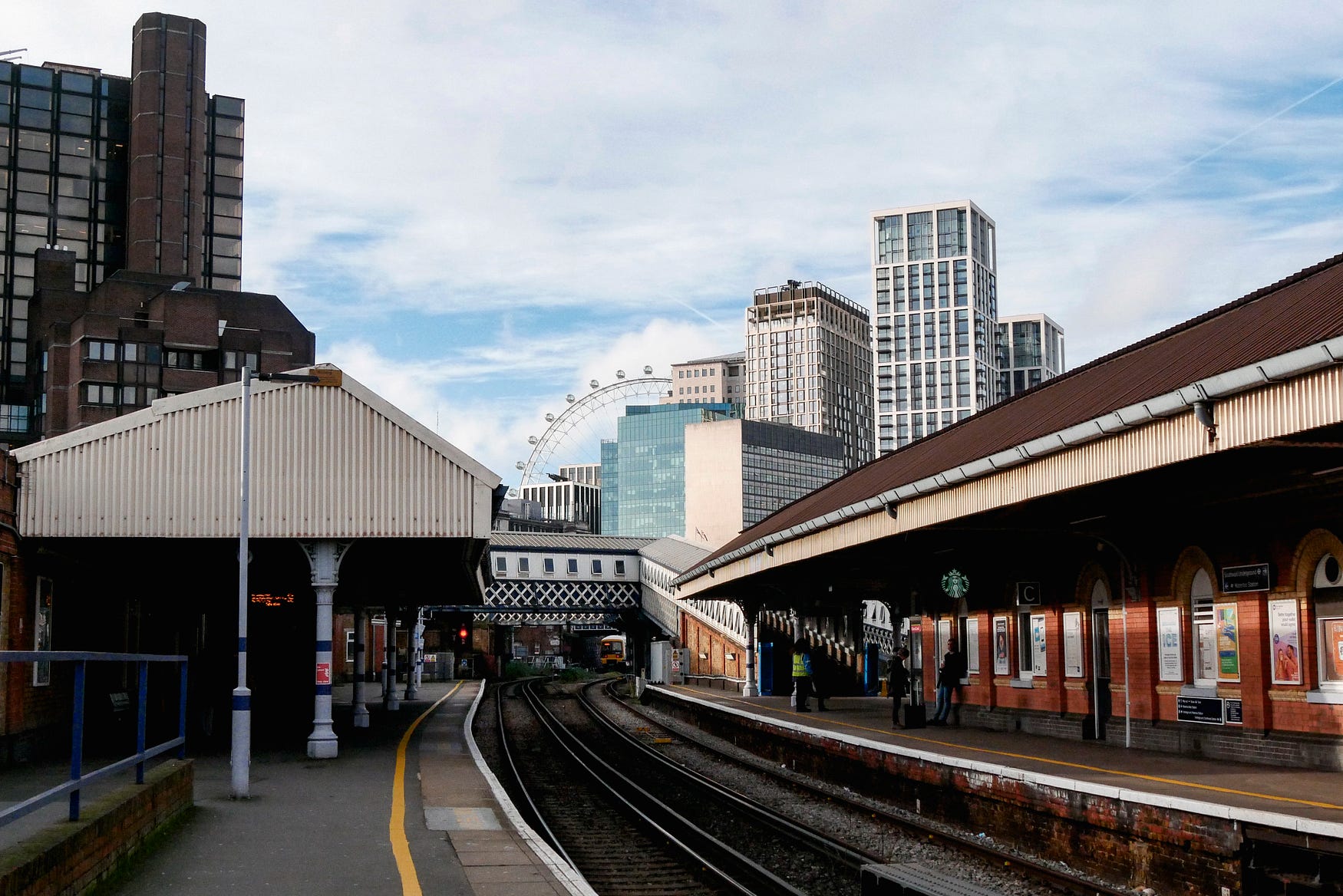
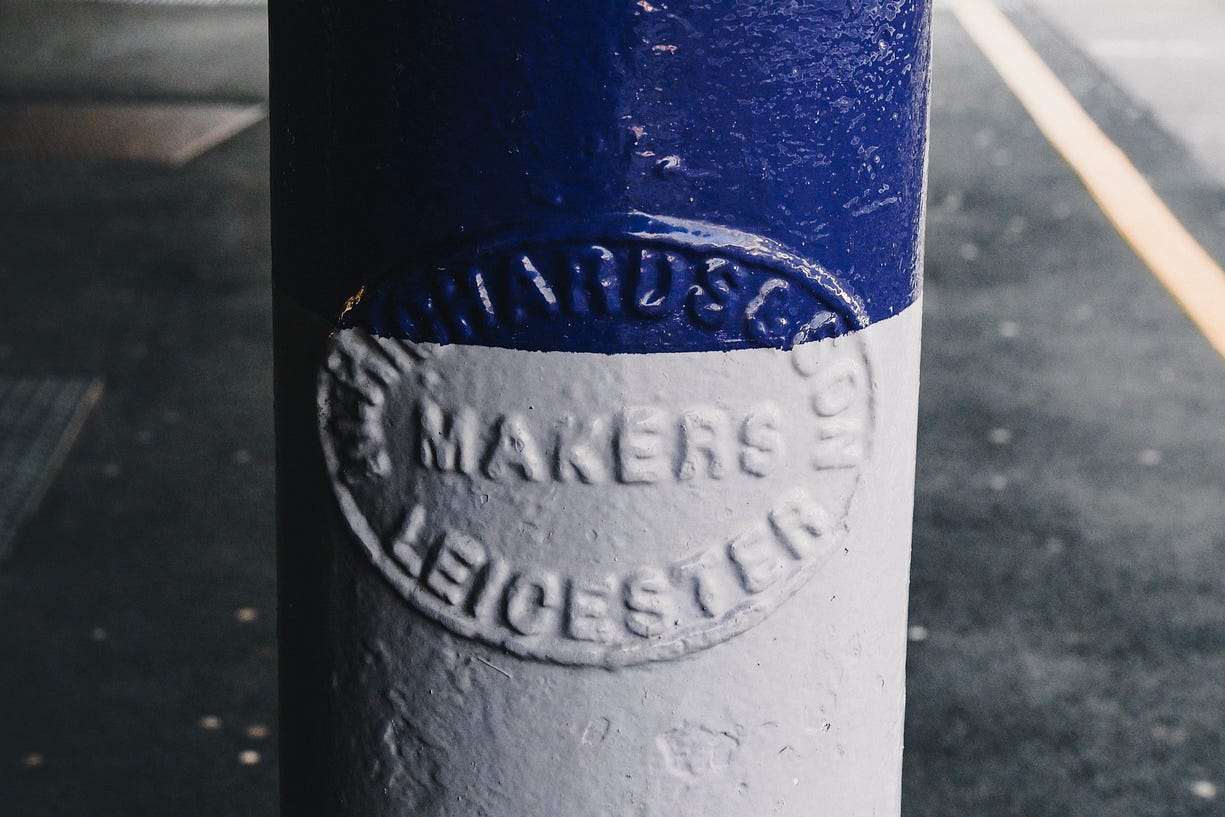
We took a short walk to Waterloo, which just looks like other London Terminals. Unlike other terminals, the entire concourse is slightly curved.
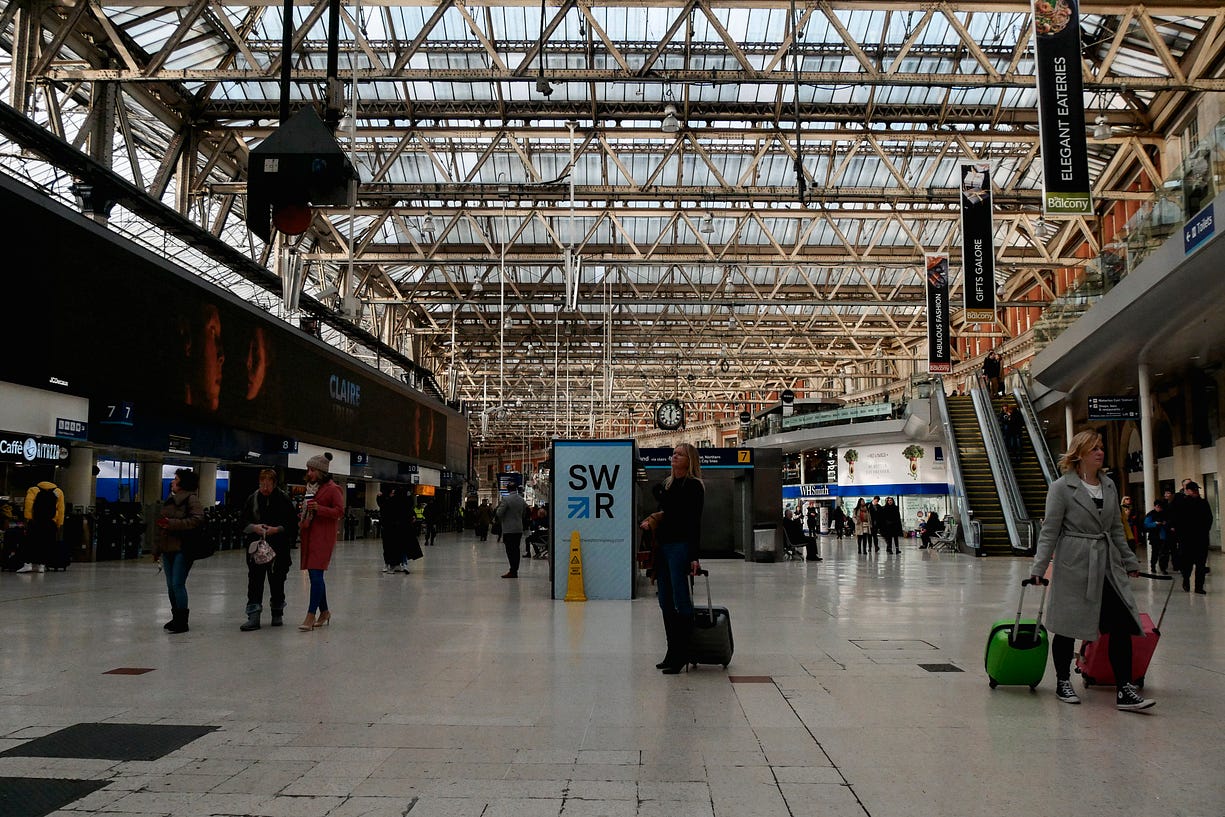
We then boarded our Southwestern train to Clapham Junction, from the old Eurostar Waterloo international terminal. It was reopened a few years ago after being defunct for nearly 10 years. I can’t really imagine how the managed to fit customs and all sorts of facilities when Eurostars used to terminate here.
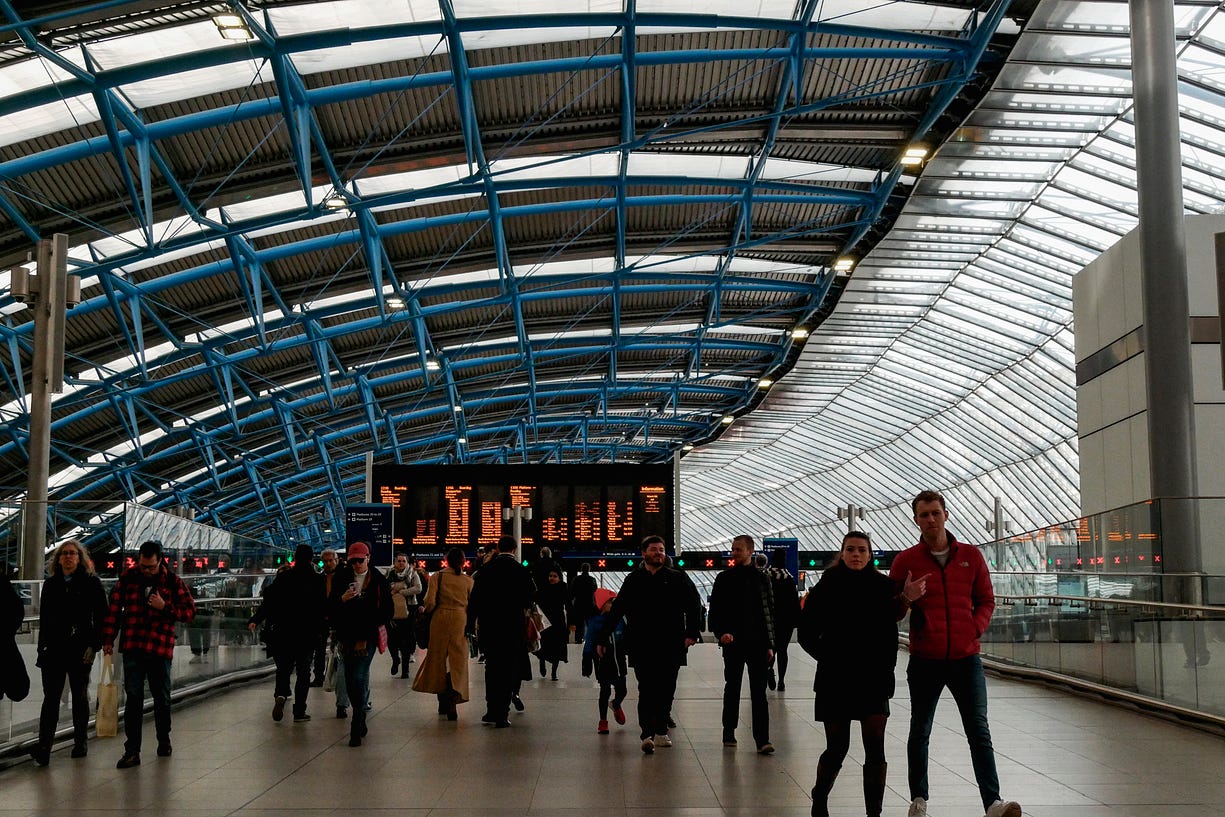
After a short ride, we arrived at Clapham Junction. The orange of the violin case matches the South Western colour scheme very well.
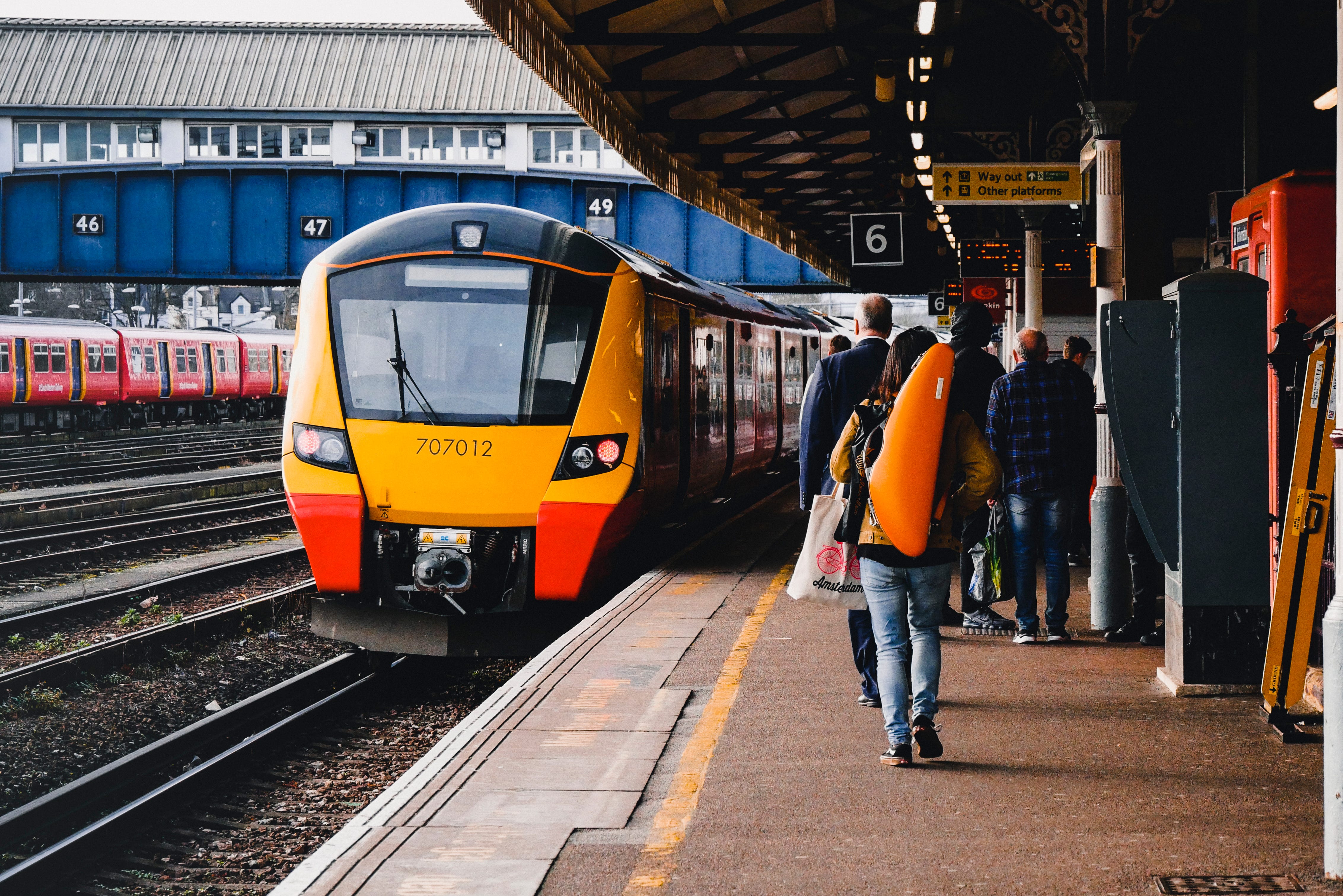
And I think we spent nearly 15 mins staring at the Class 458s from the bridge across the Clapham Junction Platforms. I think we would have stayed there a bit longer if we weren’t about to exceed our maximum journey time.
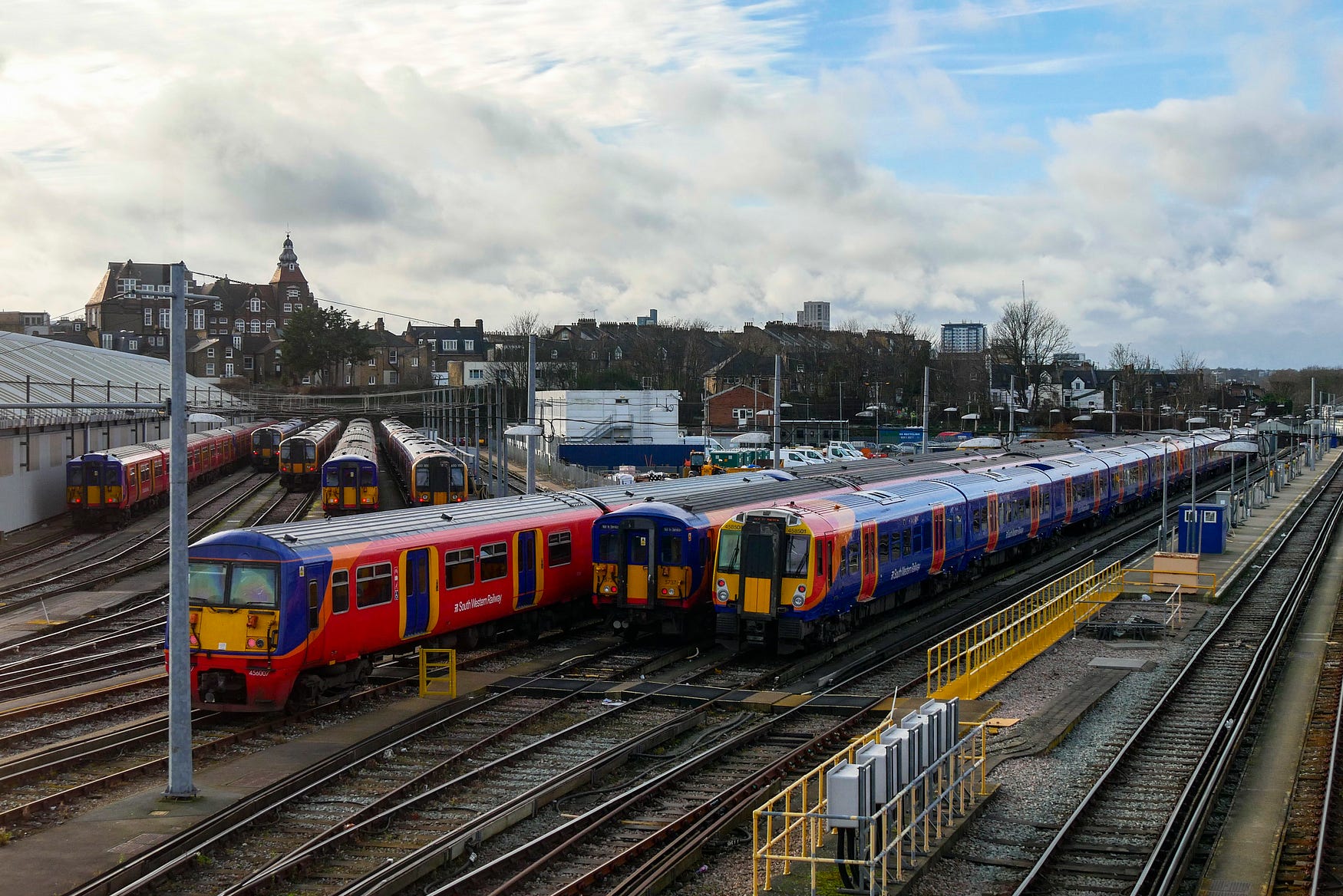
Here’s another panoramic view of the shed at Clapham Junction. This rounds up leg 2. The view is quite magnificent, isn’t it?
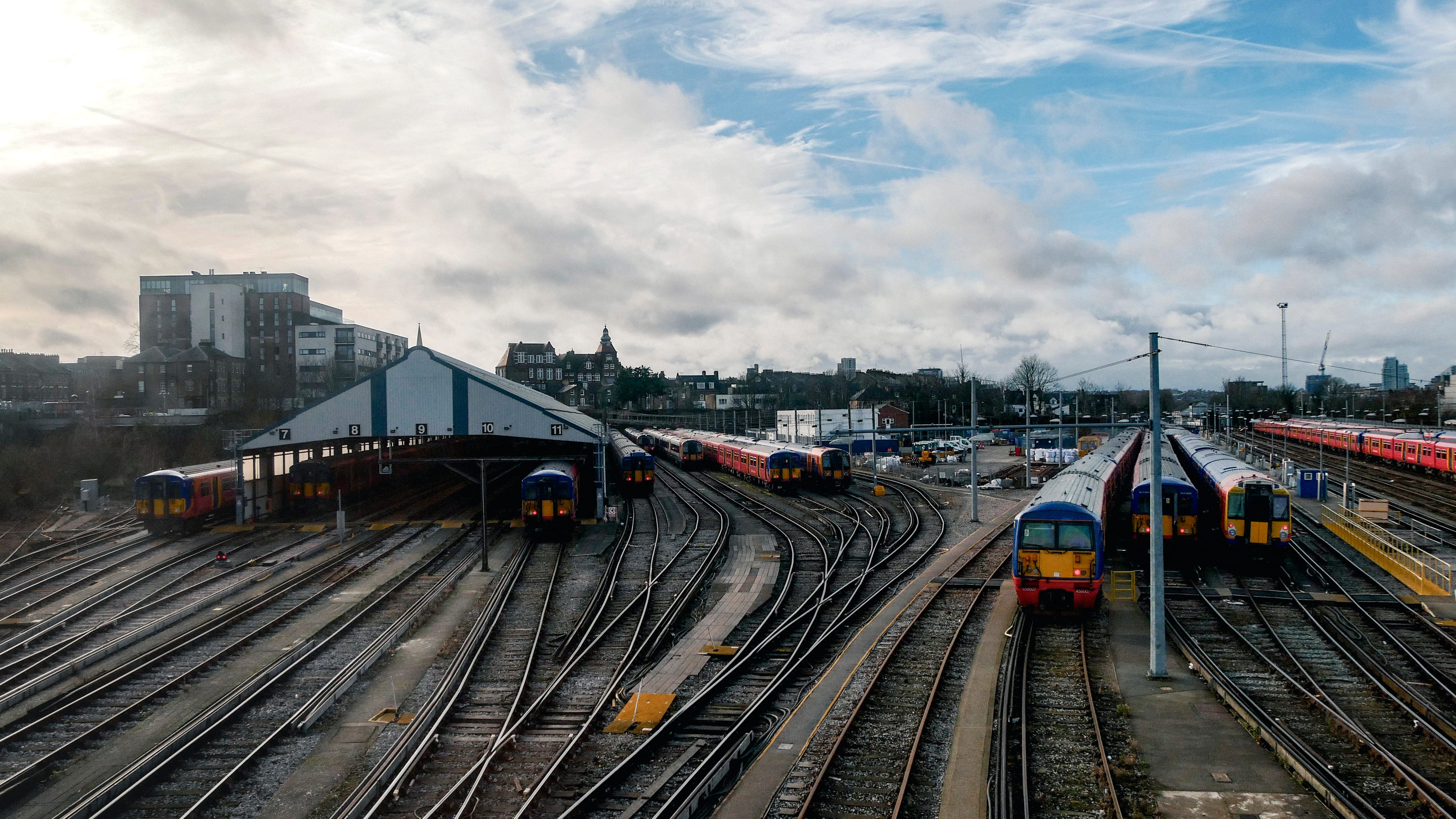
Leg 3
After hastily having lunch, we boarded the one per hour Southern service from Clapham Junction to Watford Junction.We actually ran for this train, because we were running out of time; normally it would be delayed after travelling a long distance from the South, but there were engineering works going on in the south, meaning that the train would leave from Clapham Junction, it’s temporary southern terminus, on time.
The train did have an 8-seat first class section, but the seats didn’t look that different from the regular class seats. I believe they aren’t going anywhere soon given that they are still on commuter services like Thameslink, so I guess that means a bit more time to scam clueless rich passengers! Sometimes I wish TfL and national rail can be a bit more transparent when it comes to pricing, but I guess they aren’t really making any net profit anyways.

Since we had a bit of time at Watford Junction, we did quite a bit of trainspotting. A few Pedolinos passed by. I really think that the livery looks weird at the moment with the completely white-washed side, but I guess now’s the chance to stare at them before they get repainted with the new Avanti West Coast colours.
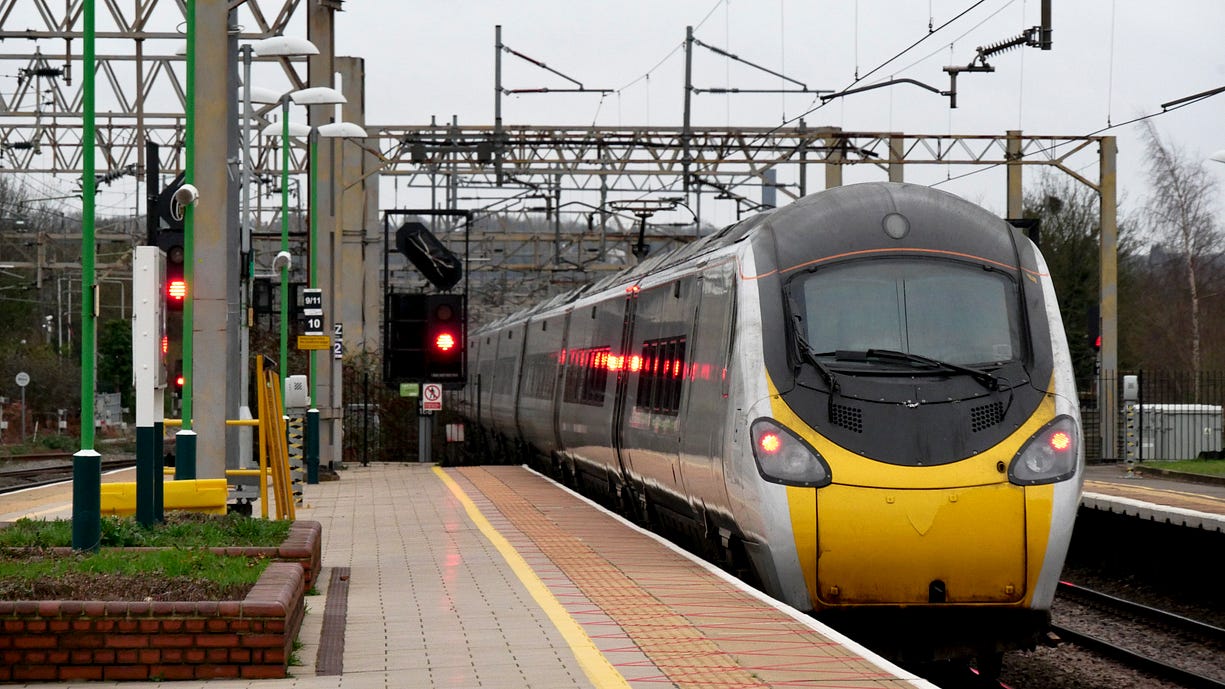
When the train passed the station, the whole message on the electronic display reads “Tickets bought at this station are not valid on this train”. Passengers are allowed to alight, but not board Avanti West Coast trains to Euston at this station. I presume that’s because West Coast Mainline tickets are sold at a higher fare class.
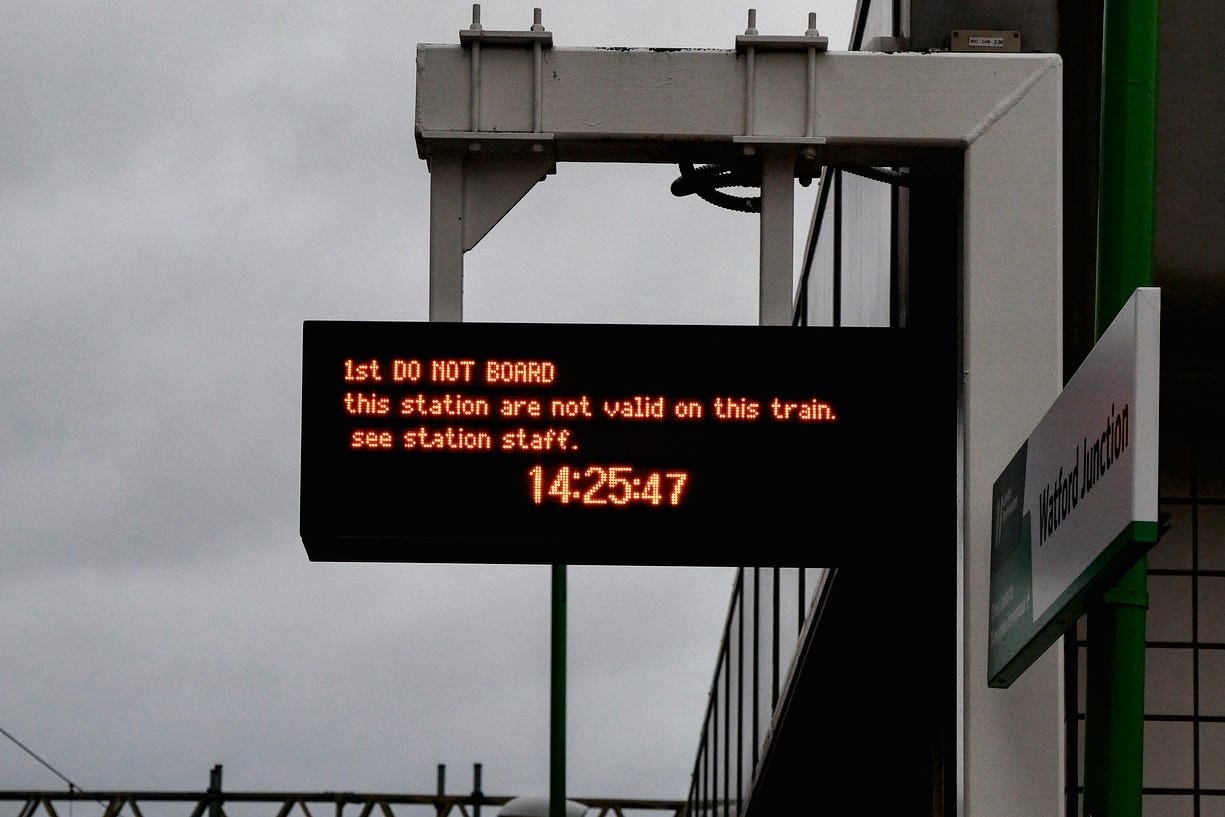
Another one of the cases where completely different looking carriage merge together to form one service. I still haven’t gotten used to this idea yet.
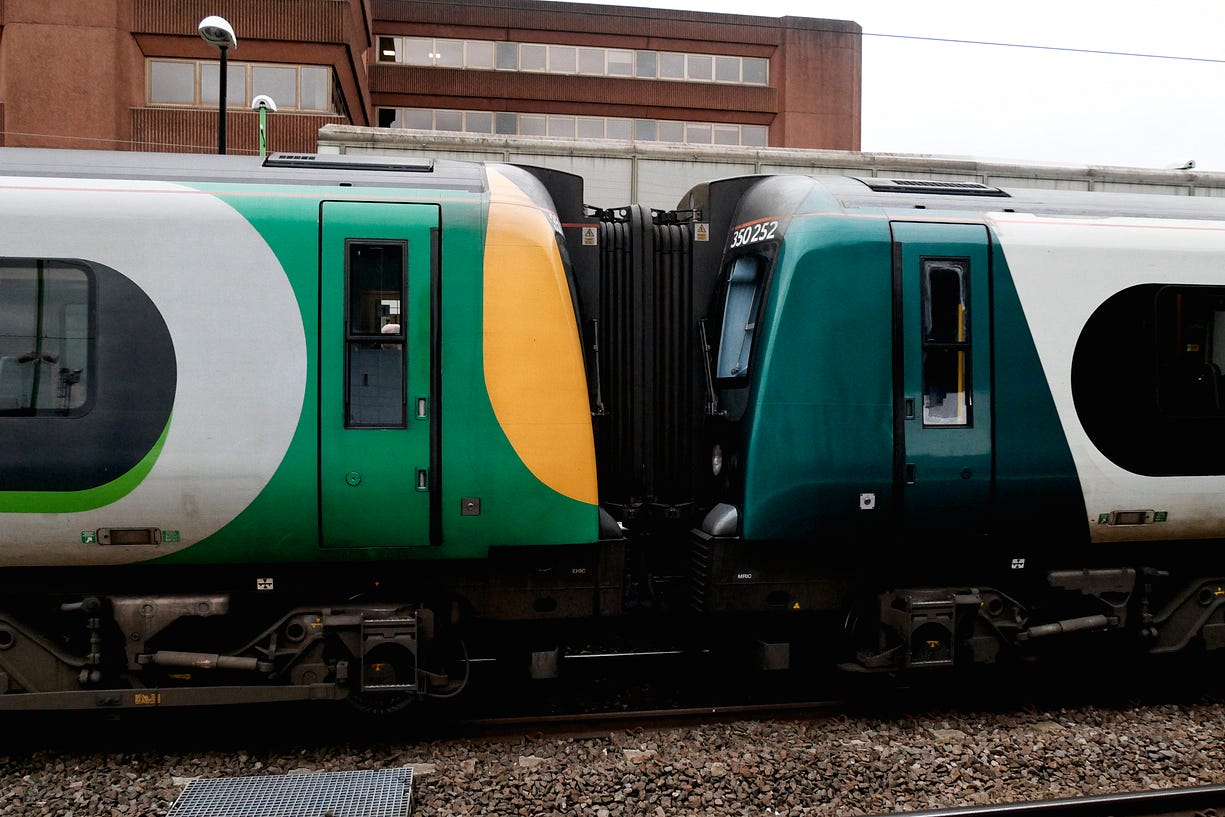
A vier of that class 350 train as it departed Watford Junction.
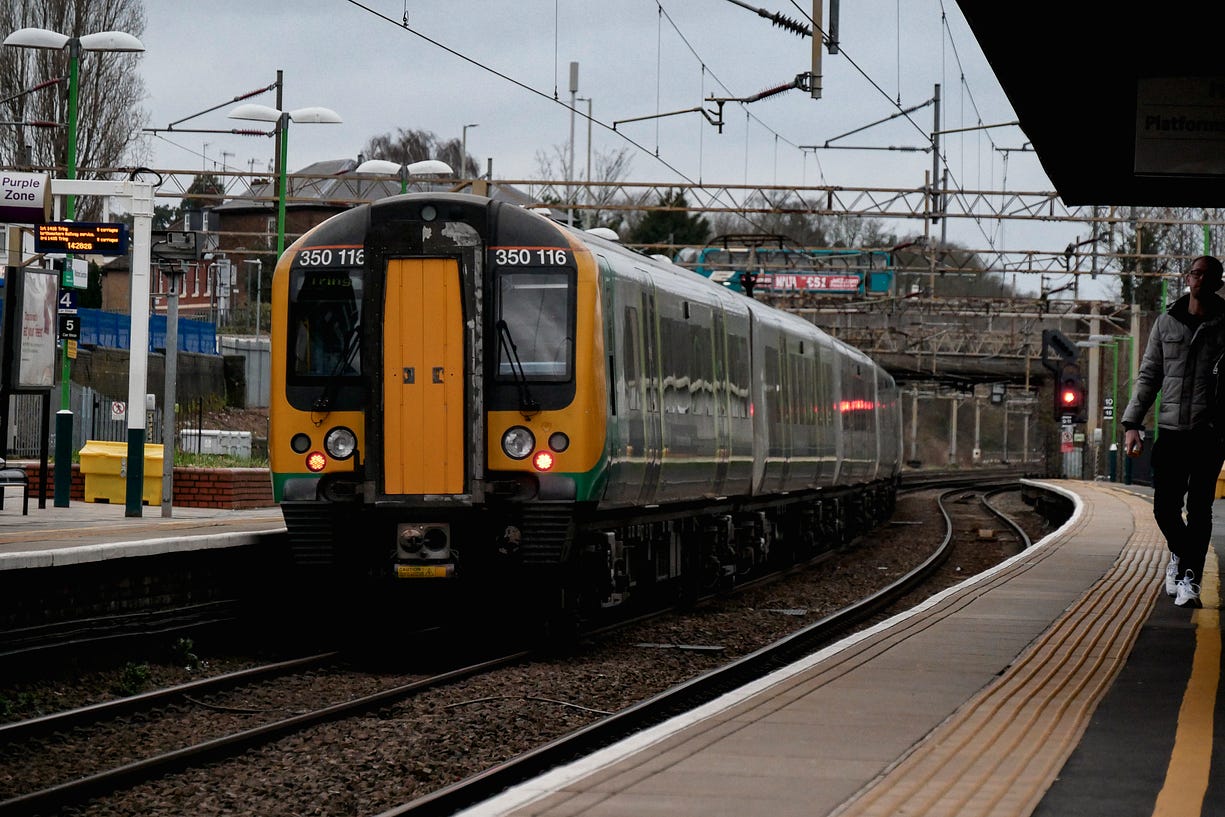
Before we continued our journey back to London Euston, we had a 5 minutes window. We ran through the underpass to take a quick peek at the class 319 train departing for St Albans Abbey. The class 319 used to serve Thameslink, which explains why the train has blue doors, which are unfortunately not very viewable in the photos below.
As the train departed, the driver honked, perhaps to give me a wave, or to warn Matthew who was standing a bit too close to the platform edge. Oddly enough, the driver was at the rear end of the train rather than the front end. This doesn’t matter anyways since the train was almost empty and the driver could have walked back to the other end pretty easily.
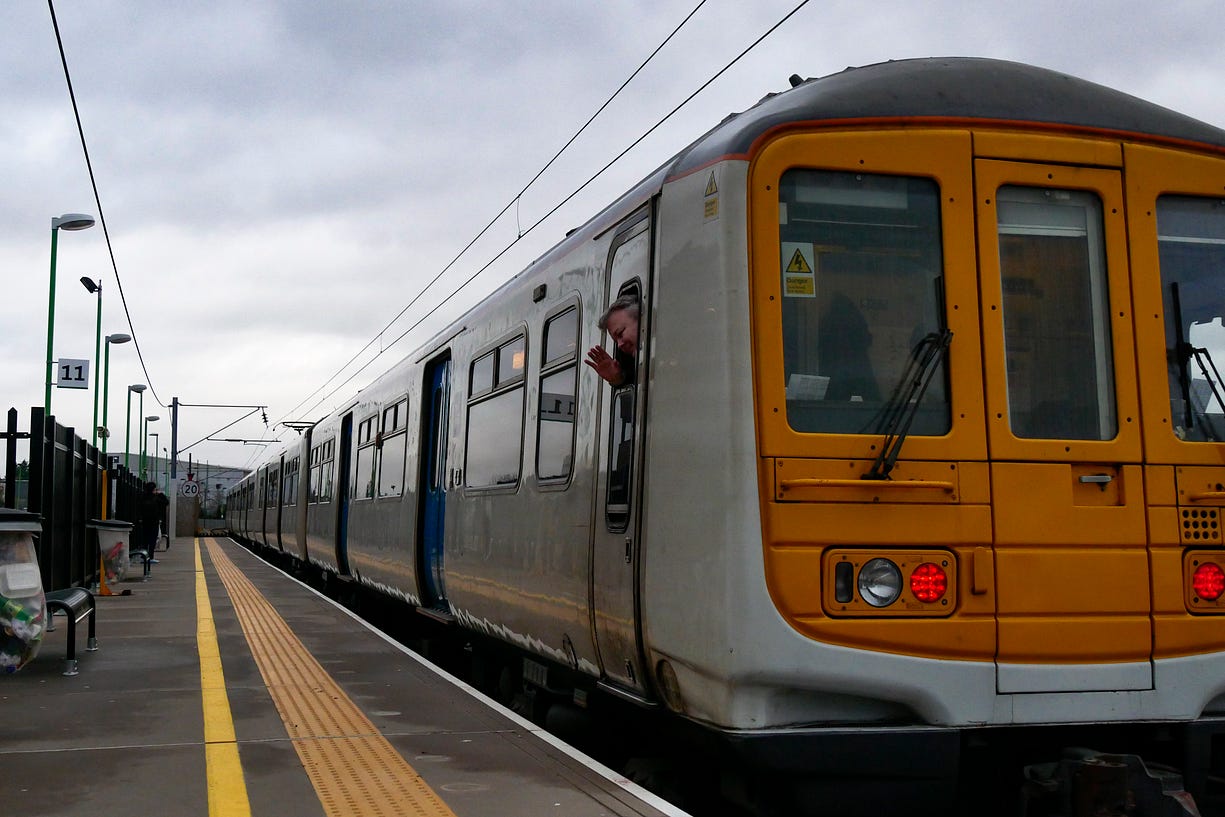
I retouched this photo to emphasise the yellows of the train itself and the tactile paving system.
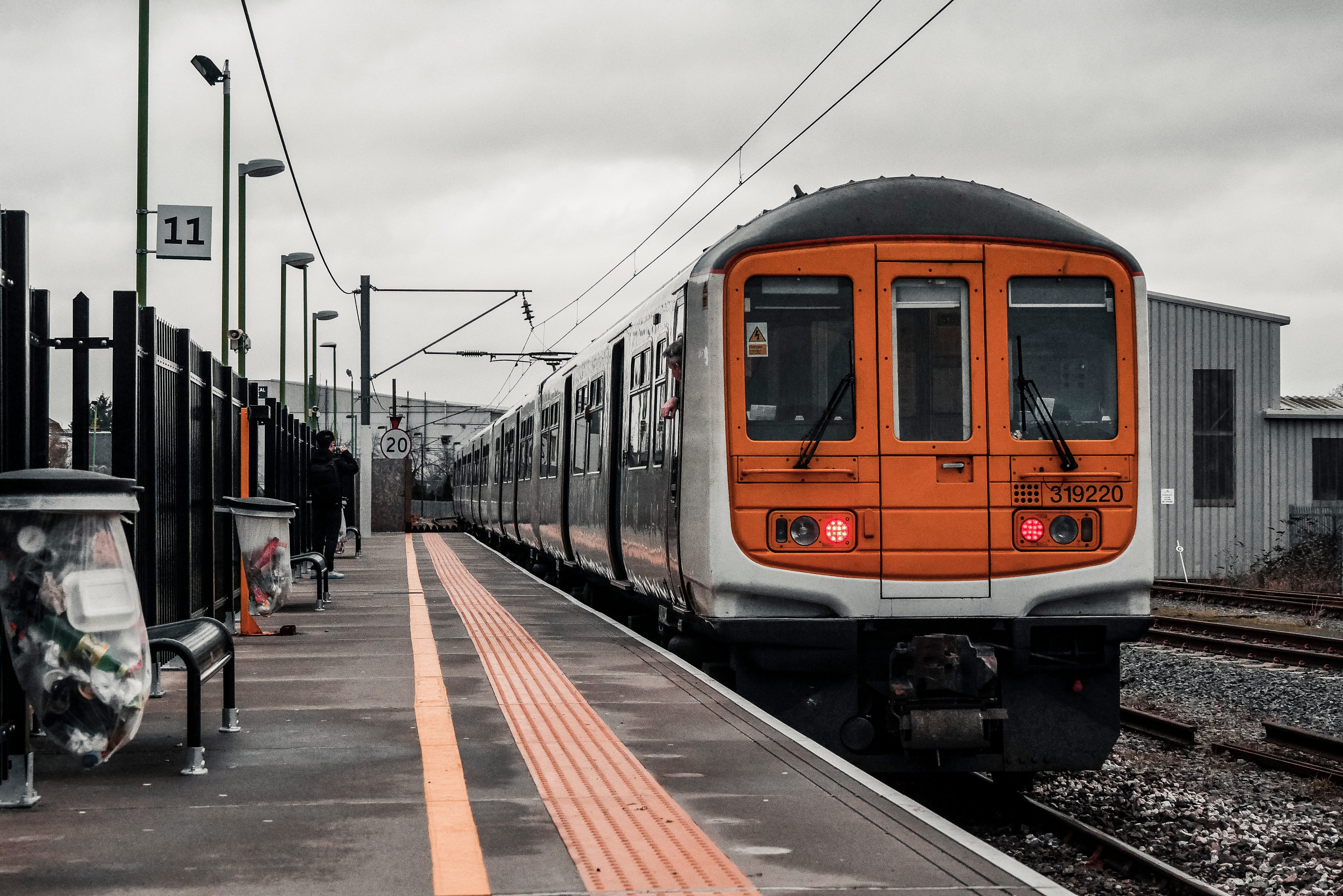
Many Metro Cammell Trains in the UK have motors that sound like the ones on the east rail line in Hong Kong, and this one in particularly so. Though not entirely relevant to this train at this location, it was this moment that I realised that all British trains (not underground or DLR trains) have yellow front panels. Turns out this is not a coincidence at all. When the 1950s came by, the industry started using newer diesel and electric trains that were far faster and quieter than their steam counterparts. Consequently, to make trains more visible, the legistration mandates yellow front panels on all trains. A newer standard didn’t come until 2015, which no longer includes this requirement but establishes new requirements for frontlamps. That’s why trains as new as the GWR Class 800s still have a yellow “nose”.
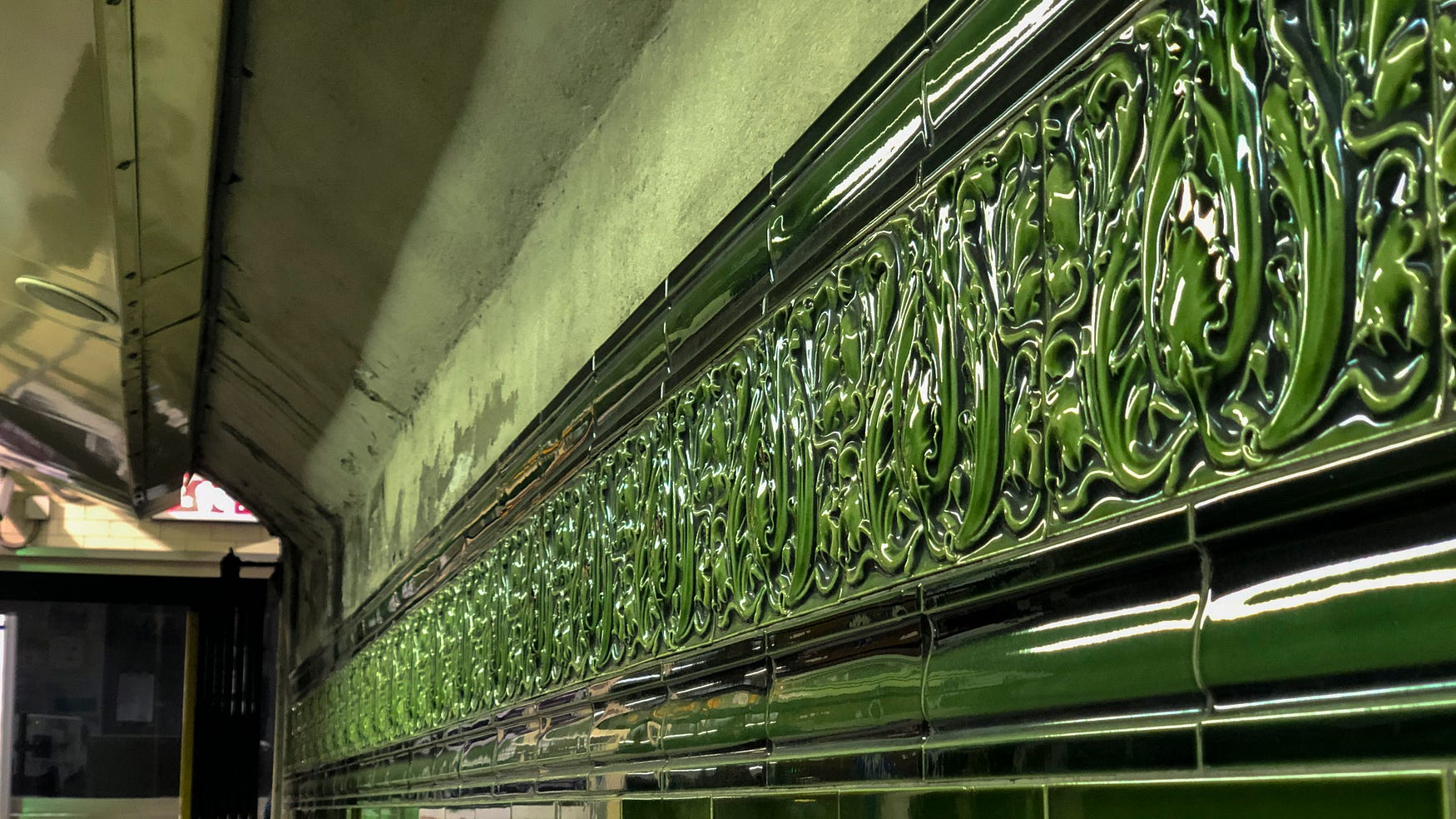
Remaining Leg(s)
After arriving at Euston, we took a short walk to Reagent’s Park, where we then took the Bakerloo line trains up north (again) to Harrow and Wealdstone.
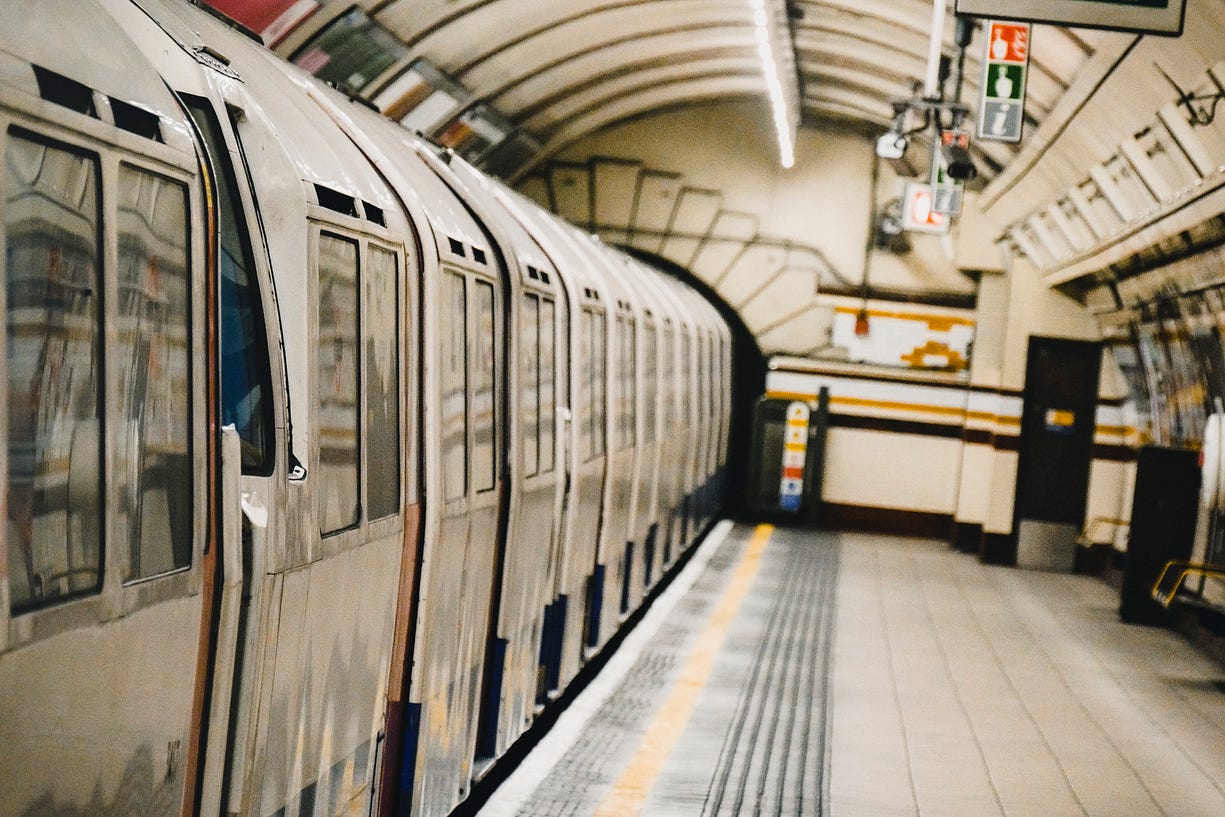
Harrow and Wealdstone is the northern terminus of the Bakerloo line, and it is interesting in that both overground and underground trains here stop at the same platform. This means that you take a significant step down into the underground train and a significant step up on to the overground train. Hence the names “underground” and “overground”?
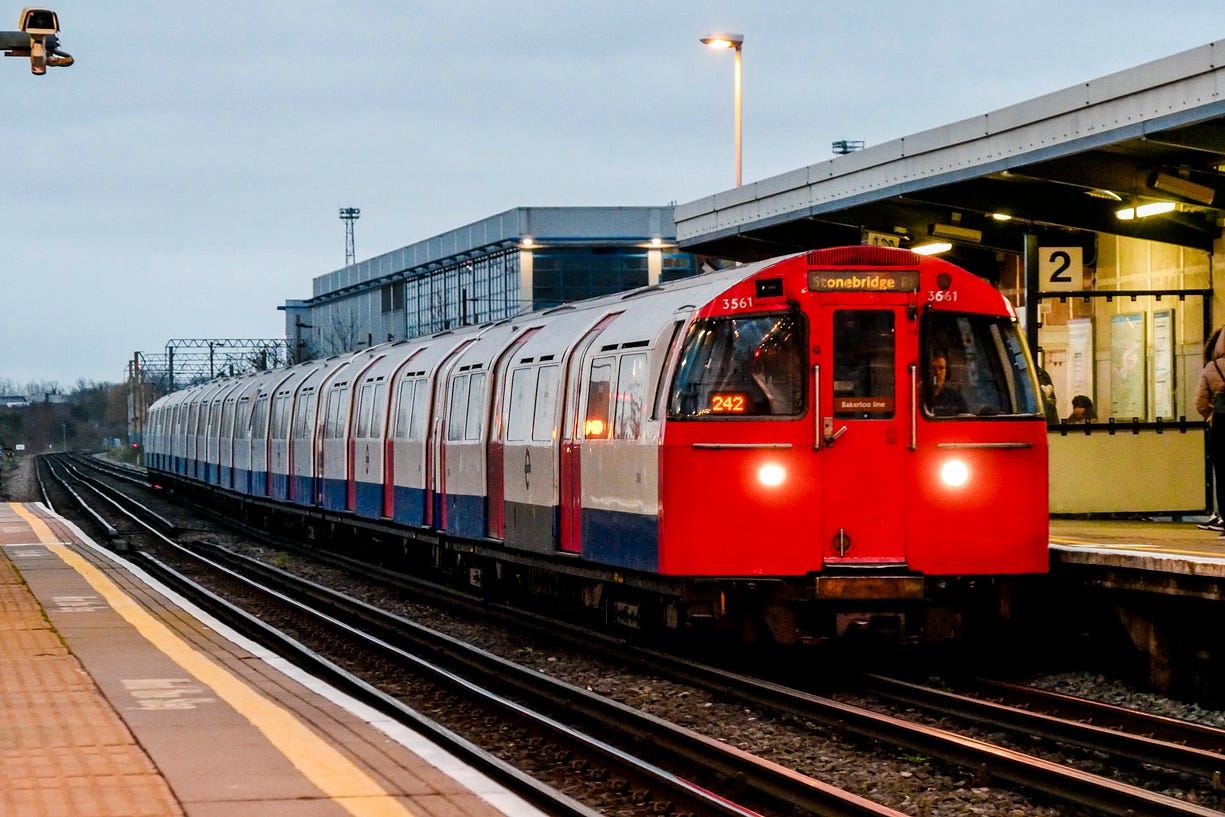
At the station, we can see the distinctly different formatting for the ETAs of underground and overground services.
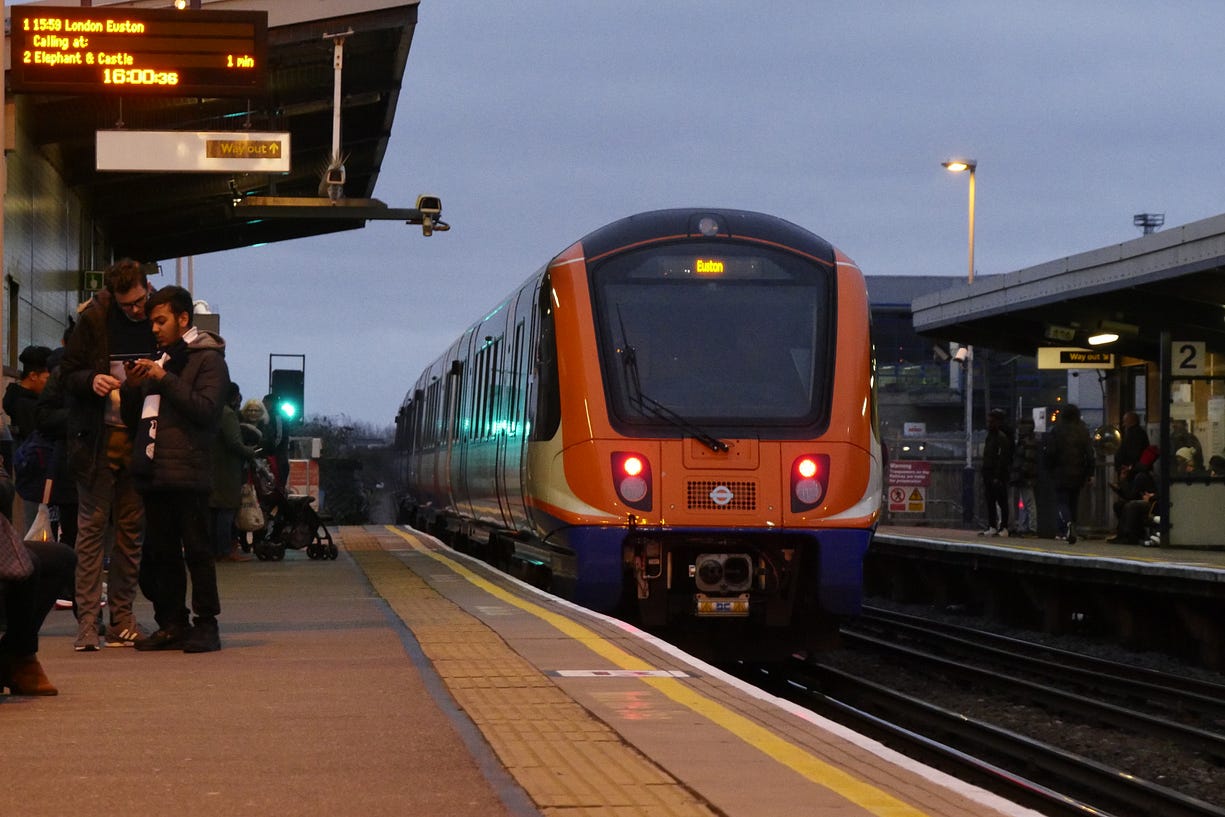
I wish I could get a photo of an underground train right next to the overground train, but unfortunately overground come a lot less frequently, which reduces the chances of this happening. This is also not accounting for the fact that London overground experiences quite a bit of delays……
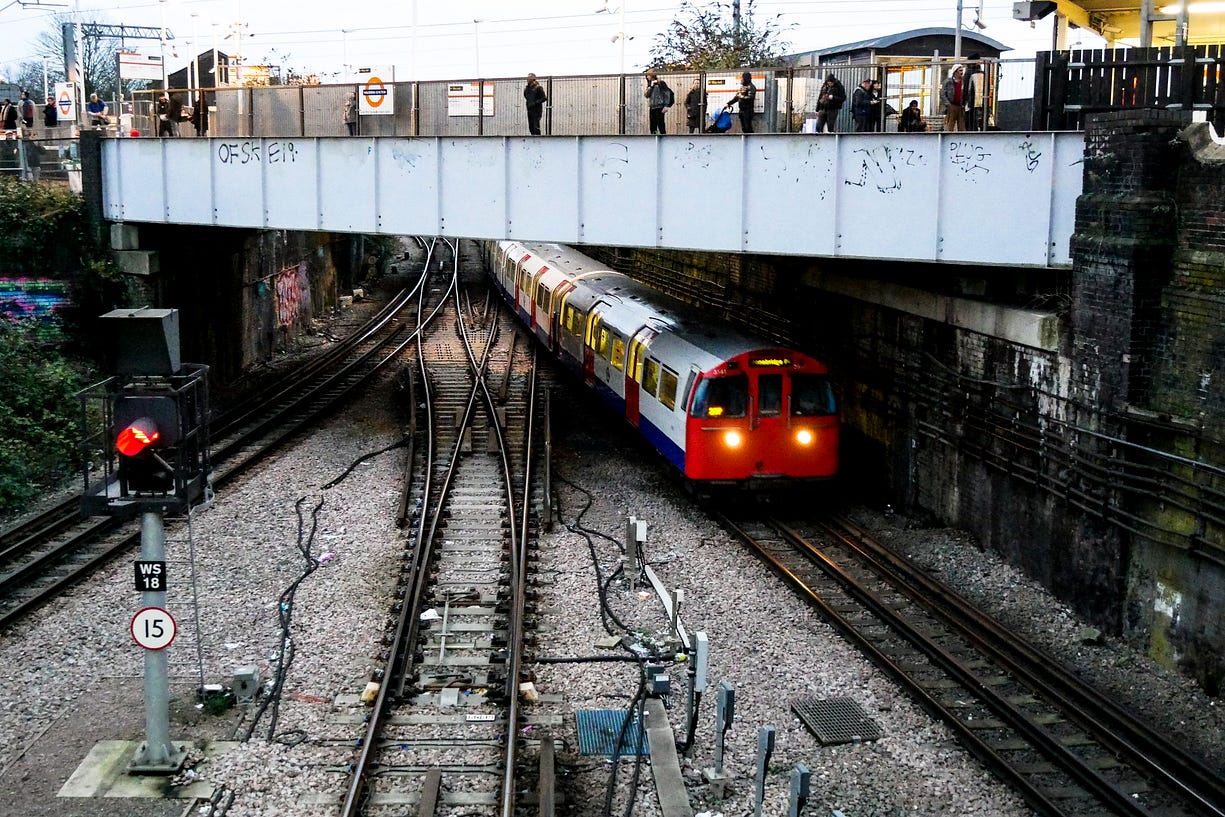
And with this in mind, we finished the day within the zone 1 to 2 daily cap.
With this coronavirus situation escalating quite quickly, plane prices from London to Hong Kong has skyrocketed. For instance, some economy CX flights from London to Hong Kong are currently priced at $50000 HKD. We also have to consider that travelling in a pressurised and densely-packed cabin is risky.
I wonder what the options are available if we travel by train instead.
- London St-Pancras to Paris Gare du Nord; prices start at £29, which is a Eurostar promotion
- Paris Gare de l’Est to Moscow Belorussky; prices start at €313
- The Trans-Manchurian service from Yaroslavsky to Beijing; prices start at £555
- High speed train from Beijing West to Hong Kong West Kowloon; prices start at ¥1077.
In summary, this rounds up to a 9 day trip (assuming you start on a Thursday) that costs a slight bit below £1000. Is this worth it? Maybe. But the thing is the high speed service has already been suspended, so this idea is entirely out of discussion anyways. Plus, travelling on a train isn’t necessarily safer than travelling on a plane, since a train cabin is also slightly pressured duirng high speed and high altitude journeys. This also doesn’t account for the greater risk as you encounter more people during a train journey.
Closing train of thoughts (again)
Perhaps the title of the previous blog “mind the trains” better suits this blog, especially at this very moment, given that it’s really not safe to travel in the underground. This is a list of stations closed on the underground network:
Underground stations facing closure from Thursday:
- Bakerloo Line: Lambeth North, Regents Park, Warwick Avenue, Kilburn Park, Charing Cross
- Central Line: Holland Park, Queensway, Lancaster Gate, Chancery Lane, Redbridge
- Circle Line: Bayswater, Great Portland Street, Barbican
- District Line: Bow Road, Stepney Green, Mansion House, Temple, St James’s Park, Gloucester Road
- Jubilee Line: Swiss Cottage, St John’s Wood, Bermondsey, Southwark
- Northern Line: Tufnell Park, Chalk Farm, Mornington Crescent, Goodge Street, Borough, Clapham South, Tooting Bec, South Wimbledon, Hampstead
- Piccadilly Line: Caledonian Road, Arsenal, Covent Garden, Hyde Park Corner, Bounds Green, Manor House
- Victoria Line: Pimlico, Blackhorse Road
Until next time, admist this coronavirus situation, I wish all the best to those of you who are staying in Europe, and please, for those of us who have just returned back to Hong Kong, please stay at home, please.
Meanwhile, happy self-isolation!